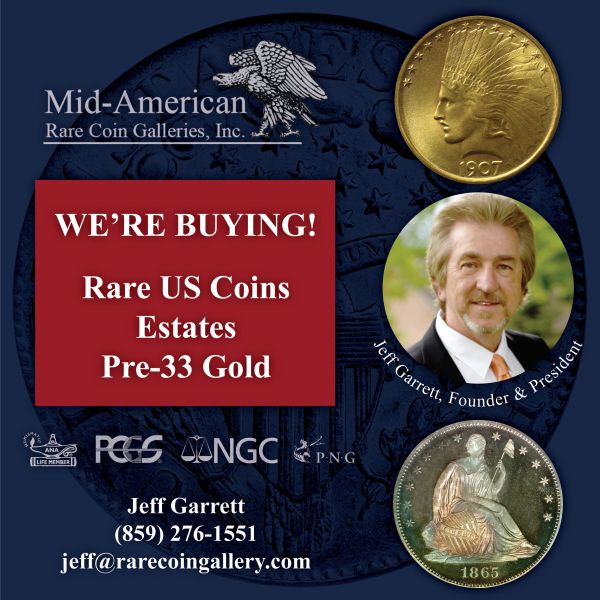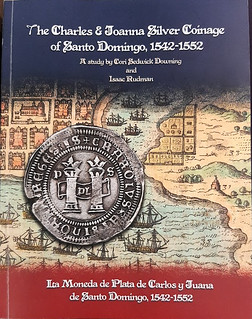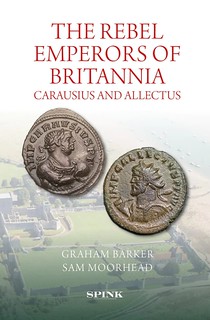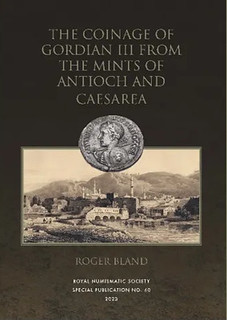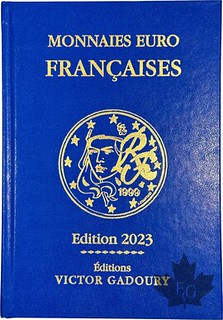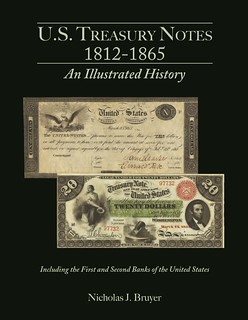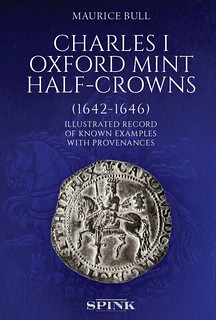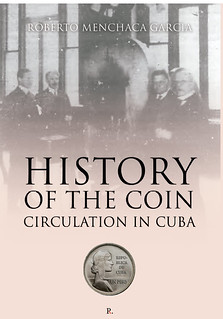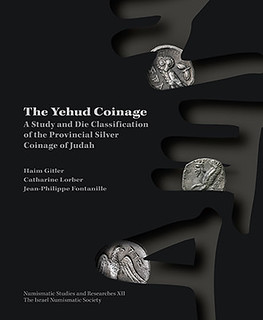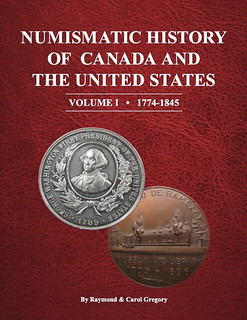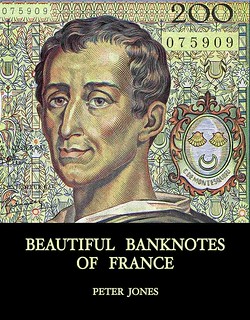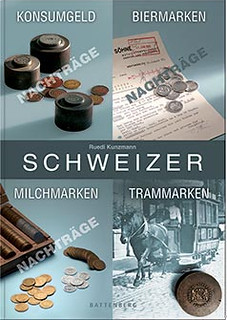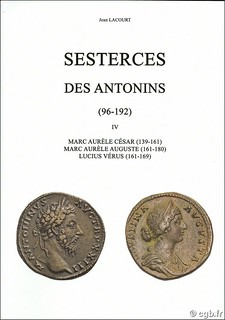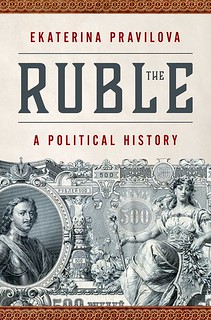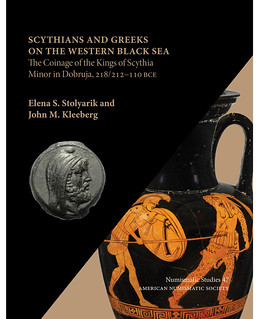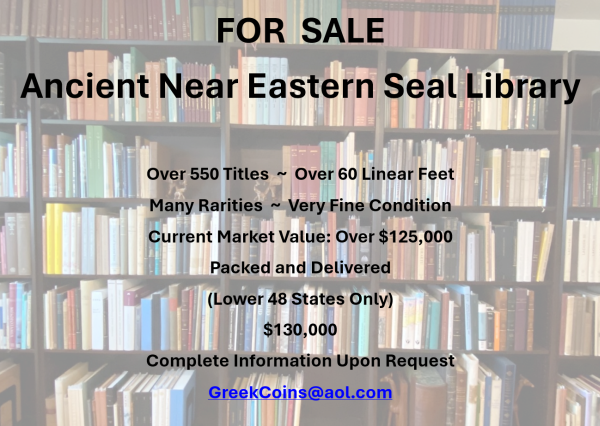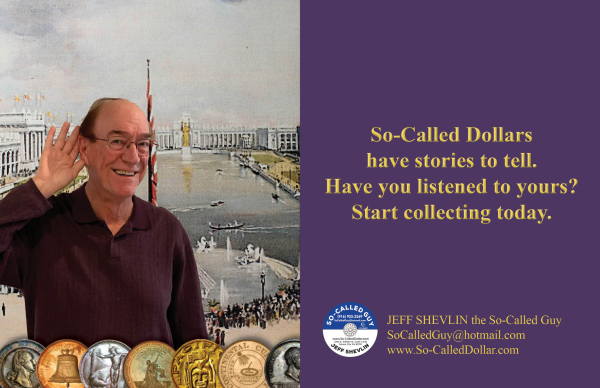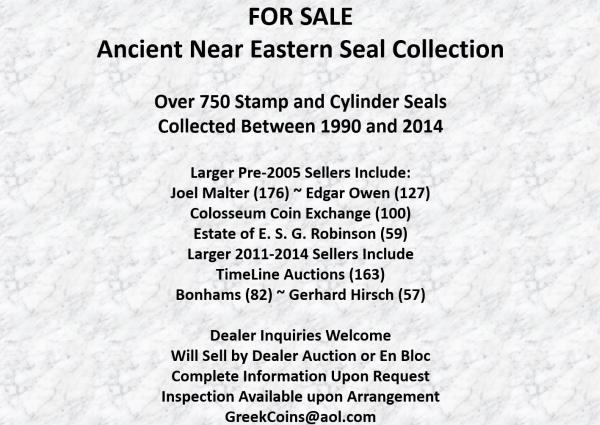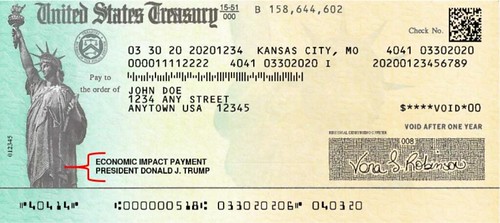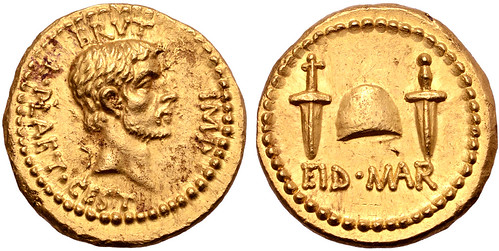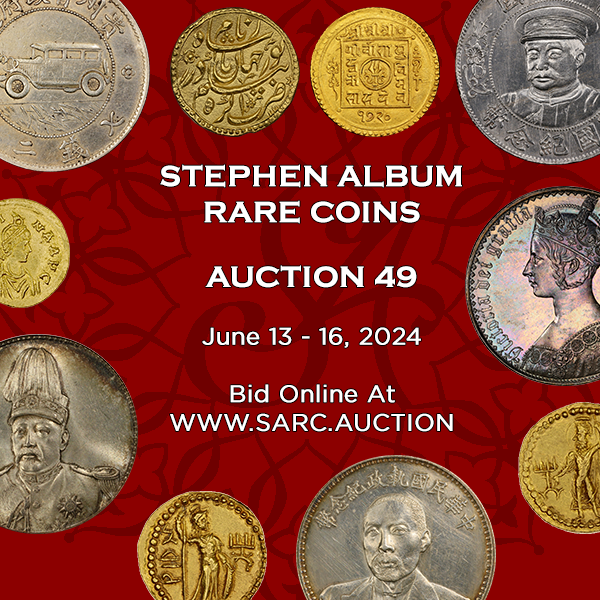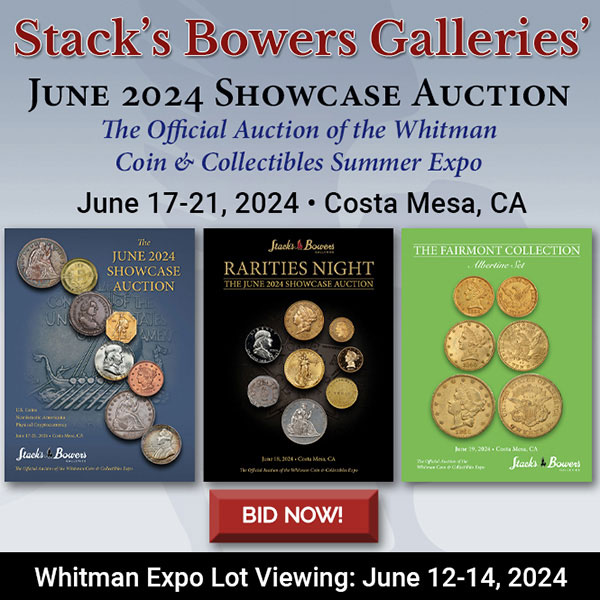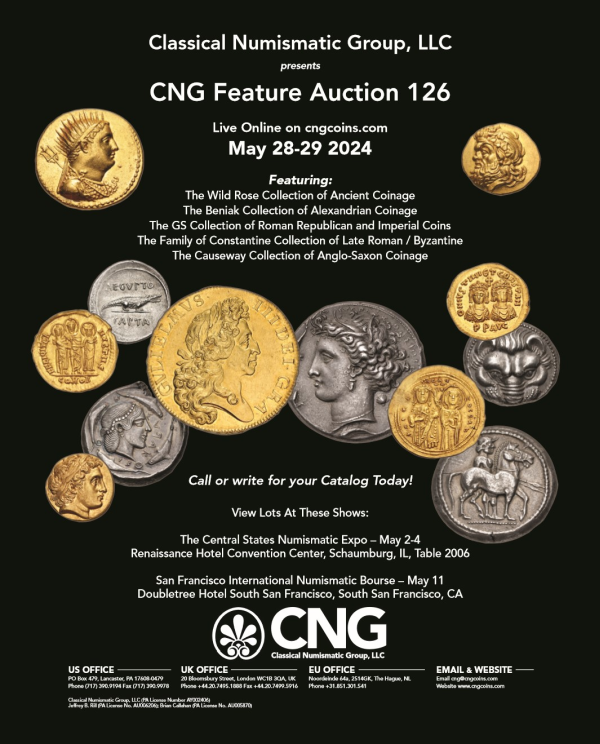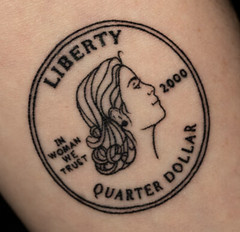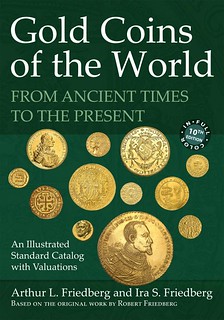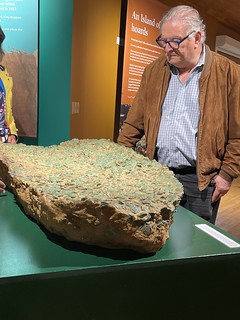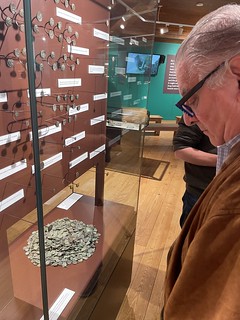
Visit our NBS Sponsors
About UsThe Numismatic Bibliomania Society is a non-profit association devoted to the study and enjoyment of numismatic literature. For more information please see our web site at coinbooks.org SubscriptionsThose wishing to become new E-Sylum subscribers (or wishing to Unsubscribe) can go to the following web page link MembershipThere is a membership application available on the web site Membership Application To join, print the application and return it with your check to the address printed on the application. Print/Digital membership is $40 to addresses in the U.S., and $60 elsewhere. A digital-only membership is available for $25. For those without web access, write to: Jeff Dickerson, Treasurer AsylumFor Asylum mailing address changes and other membership questions, contact Jeff at this email address: treasurer@coinbooks.org SubmissionsTo submit items for publication in The E-Sylum, write to the Editor at this address: whomren@gmail.com BUY THE BOOK BEFORE THE COIN |
- WAYNE'S WORDS: THE E-SYLUM MAY 26, 2024
- ASYLUM SUMMER 2024 ISSUE PUBLISHED
- KOLBE & FANNING JUNE 2024 SALE ANNOUNCED
- COIN BOARD HOARD SALE
- 2024 IAPN BOOK PRIZES ANNOUNCED
- MAY 2024 NNP SYMPOSIUM VIDEOS AVAILABLE
- NEWMAN GRANTS 2024 AWARD ANNOUNCEMENT
- VIDEO: HISTORY OF WELLS FARGO
- 2024 PNG AWARDS NOMINATIONS NOW OPEN
- MORE ON EARLIER BRUUN COLLECTION SALES
- NOTES FROM E-SYLUM READERS: MAY 26, 2024
- ROMA NUMISMATICS CEASES OPERATIONS
- OWEN LINZMAYER JOINS CDN PUBLISHING
- VOCABULARY TERM: PLASTER CASTING
- ALFRED EDWARDS EMERSON (1859-1943)
- ATLAS NUMISMATICS SELECTIONS: MAY 26, 2024
- RARE INDIA BANKNOTES FROM WWI SHIPWRECK
- THE HOWARD GIBBS ARCHIVES
- STACK'S BOWERS BRUUN COLLECTION, PART I
- WAYNE'S NUMISMATIC DIARY: MAY 26, 2024
- DR. STAHL VISITS JERSEY COIN HOARD
- USING AI TO ANALYZE COIN HOARDS
- WWII POW DOG DICKIN MEDAL LETTER
- CROCODILE-PUNCHING WOMAN'S MEDAL
- COIN DONATIONS OVERWHELM AUTISTIC BOY
- $1 MILLION LEFT AT AIRPORT SECURITY
Content presented in The E-Sylum is not necessarily researched or independently fact-checked, and views expressed do not necessarily represent those of the Numismatic Bibliomania Society.
WAYNE'S WORDS: THE E-SYLUM MAY 26, 2024
 New subscribers this week include:
Evan Saltis,
Jim Turner, and
J. Patrick Wooten.
Welcome aboard! We now have 7,262 subscribers.
New subscribers this week include:
Evan Saltis,
Jim Turner, and
J. Patrick Wooten.
Welcome aboard! We now have 7,262 subscribers.
Thank you for reading The E-Sylum. If you enjoy it, please send me the email addresses of friends you think may enjoy it as well and I'll send them a subscription. Contact me at whomren@gmail.com anytime regarding your subscription, or questions, comments or suggestions about our content.
This week we open with sales of numismatic literature and coin boards, the IAPN Book Prizes, updates from the Newman Numismatic Portal, notes from readers, and more.
Other topics this week include Wells Fargo, the Bruun collection, Roma Numismatics, plaster casting, fixed price and auction selections, my numismatic diary, and the Jersey coin hoard.
To learn more about The Missing Book, Howard Gibbs, the M.K. McMullin collection, the Robert Friedberg Award, my Personal Time Tunnel, a Buick encased silver dollar, Dr. Alfred Emerson, numismatic tattoos, spatulation, and the crocodile-punching woman, read on. Have a great week, everyone!
Wayne Homren
Editor, The E-Sylum
ASYLUM SUMMER 2024 ISSUE PUBLISHED
The Summer 2024 issue of the print journal The Asylum is on the way from our sponsor, the Numismatic Bibliomania Society. Another great issue, with lots of interesting reading and research. Thanks and congratulations to all the contributors. -Editor
Welcome to The Asylum's Summer 2024 edition.
- A Little Dry Reading for the Antiquaries (Part Four) By Joel J. Orosz
- The Missing Book By Charles Sullivan
- Good Numismatic Reads By Jeff Dickerson
- A Bibliographic Study of United States Commemorative Coinage Literature By Mike Costanzo
- Forgery or Reproduction—An Analysis By Shanna Schmidt
- A Piece of Very Important, Coin-Related, (non) Numismatic Literature By Greg Bennick
Message from NBS President Len Augsburger
Welcome to the second Asylum issue of the (not so new) year, and as always, a big thanks is in order to our contributing authors and our editor Maria Fanning. While it is easy enough to enjoy literature on its own, the experience becomes more impactful when one researches a particular item and shares findings with fellow collectors. If you have not yet so taken pen in hand, I encourage you to pick a favorite item in your library and dig in.
I would like to make mention of the NBS Facebook page (https://www.facebook.com/groups/1145253708909091). Bryce Brown and others continually post interesting items, and the related discussion is stimulating. Posts from just the past few days, as this is written, include a prospectus for Loubat's masterpiece, The Medallic History of the United States of America, and the inaugural issue of the MANA Newsletter from 1953. Social media may be a guilty pleasure but learning about literature at the same time at least allows the bibliophile to rationalize a few idle moments!
As always, we welcome donations of numismatic literature for the annual Charity Auction, which will be held at the ANA convention in August. The Charity Auction covers a good portion of the NBS annual expenses, and we gratefully acknowledge past donors and bidders. While material at varied price points is welcome, we especially encourage donations of literature valued at $100 and up. Please do check with either David Fanning or me before sending material. We hope you can attend the Charity Auction in person, but in any case the catalog will be posted online prior to the event, so that all members may participate by contacting David or me with bids beforehand.
NBS Meeting Times at the ANA World's Fair of Money in Rosemont:
- NBS board meeting, room 10 - Thursday, August 8 11:30AM
- NBS Symposium, room 10 - Thursday, August 8 1:00PM
- NBS general meeting, room 12 - Friday, August 9 11:30AM
New NBS mailing address
With a new treasurer comes a new mailing address! Please use the mailing address for membership or other mailed correspondence.
NBS c/o Jeff Dickerson
P.O. Box 578
Weatherford, TX 76086
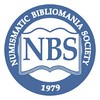 NBS Membership Renewal Time!
Please renew your membership in the NBS to continue receiving The Asylum. Go to
coinbooks.org to pay by PayPal or download a membership form today. Your current expiration date is printed to the right of your name on your subscription envelope, which should be arriving soon.
NBS Membership Renewal Time!
Please renew your membership in the NBS to continue receiving The Asylum. Go to
coinbooks.org to pay by PayPal or download a membership form today. Your current expiration date is printed to the right of your name on your subscription envelope, which should be arriving soon.
KOLBE & FANNING JUNE 2024 SALE ANNOUNCED
Kolbe & Fanning have announced their next numismatic literature sale, featuring books on ancient, world and U.S. numismatics, including another consignment from yours truly. See an article elsewhere in this issue for more information on one of the lots. -Editor
June 15 Sale of Numismatic Books
 Kolbe & Fanning Numismatic Booksellers are pleased to announce that we will be holding our next auction sale on Saturday, June 15, 2023. The sale includes rare and out-of-print works on ancient, world and U.S. numismatics from the libraries of Wayne Homren and other consignors. With over 500 lots, there is something for everybody.
Kolbe & Fanning Numismatic Booksellers are pleased to announce that we will be holding our next auction sale on Saturday, June 15, 2023. The sale includes rare and out-of-print works on ancient, world and U.S. numismatics from the libraries of Wayne Homren and other consignors. With over 500 lots, there is something for everybody.
Some highlights of this first sale include:
Lot 4: E.S.G. Robinson's set of the famous Ars Classica series of ancient coin auctions, catalogued by Dr. Jacob Hirsch
Lot 50: Leonard Forrer's 1922–1929 Descriptive Catalogue of the Collection of Greek Coins Formed by Sir Hermann Weber
Lot 65: the BCD copy of the original first edition of the BMC Greek volume focusing on the ancient coins of Corinth
Lot 110: a complete bound set of Rodolfo Ratto's 23 numbered fixed-price lists in quarto format, including a number of important catalogues
Lot 183: archives relating to Howard Gibbs and his collection, including inventories, correspondence, manuscripts, photographs, his annotated Farouk catalogue, etc.
Lot 173: a unique manuscript catalogue of the works of Augustin Dupré, compiled by his son Narcisse, the earliest catalogue raisonné of Dupré's numismatic works
Lot 327: an original copy of the 1875 edition of Sylvester S. Crosby's classic study of The Early Coins of America
Lot 345: Louis E. Eliasberg Sr.'s card catalogues, consisting of over 6000 cards recording provenance and other information on his collection of world coins, and essential information on his U.S. paper money and other items
Lot 344: a very rare plated copy of Tom Elder's 1921 sale of the M.K. McMullin collection, featuring 16 very fine photographic plates
Lot 430: the original plated copy of the New York Coin & Stamp Company's 1890 catalogue of the Lorin G. Parmelee collection from the library of A.C. Gies.
Register early to bid online
Bids may be placed via post, email, phone, as well as online. Kolbe & Fanning use Auction Mobility as our third-party online bidding platform. Auction Mobility is an app-based platform allowing users the ability to participate in the sale through phones, tablets and computers. To register for the sale, bidders must go to
bid.numislit.com and sign up. Once you have set up an account, you may browse lots, place advance bids, or participate in the live sale online. Those wishing to participate on their devices can download the Kolbe & Fanning app through the Apple or Google Play Store. The sale will also be listed on Biddr and NumisBids in the near future.
The printed catalogue has been mailed to all active customers on our mailing list. As international mail speeds have been inconsistent, we encourage our foreign clients to consult the electronic catalogue in case their printed catalogue does not arrive promptly. A PDF of the printed catalogue has been posted to our main website at numislit.com for those who prefer that format. Bids placed via post, email, fax or phone must be received by June 14, the day before the sale, in order for them to be processed. Advance absentee bids may also be placed at any time online at bid.numislit.com. Live internet bidding will be available during the sale itself through the same platform.
Kolbe & Fanning Numismatic Booksellers LLC is a licensed and bonded auction firm in the State of Ohio, and our sales are conducted by licensed auctioneers. For more information, please see the Kolbe & Fanning website at numislit.com or email David Fanning at df@numislit.com. To register for the sale, go to bid.numislit.com. We look forward to your participation
To read the Catalogue PDF, see:
https://numislit.cdn.bibliopolis.com/images/upload/kolbefanningsale170.pdf
COIN BOARD HOARD SALE
Justin Hinh (aka Dansco Dude) submitted this report on a large collection of coin boards now coming to market. This is a great opportunity to complete or start a new collection. -Editor
 I wanted to give a heads-up to The E-Sylum readership about the 'Coin Board Hoard'. In late April, I flew to Green Bay, Wisconsin to help a collector sort through and prepare for the sale of the world's largest collection of coin boards. Over 1700+ vintage coin boards, folders, and albums are coming into the market.
I wanted to give a heads-up to The E-Sylum readership about the 'Coin Board Hoard'. In late April, I flew to Green Bay, Wisconsin to help a collector sort through and prepare for the sale of the world's largest collection of coin boards. Over 1700+ vintage coin boards, folders, and albums are coming into the market.
Coin-collecting boards gained popularity in the 1930s and 1940s as a way to make the hobby more accessible to the average American family during the Great Depression era. Because coin boards were much cheaper to produce than coin cabinets, they played a significant role in popularizing coin collecting. It moved coin collecting from "The Hobby of Kings" to "The Hobby of Everyone". The boards themselves have become highly sought-after collectibles.
This particular hoard is a combined collection of two renowned figures in the coin board world: David Lange and Donald Kocken.
David Lange was a leading expert and pioneer in the study of coin boards. His book, "Coin Collecting Boards of the 1930s and 1940s" is considered the definitive work on the subject. After his passing in 2023, his collection was acquired by Donald Kocken.
Donald Kocken is a prominent researcher of coin boards, albums, & folders, known for his extensive knowledge and expertise. He authored the book "Collecting Vintage Coin Boards, Albums, Folders, & Holders: 1930's and Beyond" which has become a valuable resource for collectors. He has passed on his collection to a fellow collector to help sell off the entire collection.
The 'Coin Board Hoard' consists of 1,700 vintage coin boards, folders, and albums, many of which are among the rarest and highest-grade examples in the history of coin collecting.
 Manufacturers in this hoard include
Manufacturers in this hoard include
- Kent
- Whitman
- Dansco
- Coin & Currency Institute
- Crest
- Hobbies Unlimited
- Library of Coins
- Lincoln
- Meghrig
- Oberwise
- Shoreline
- And many more
Link to additional photos
https://imgur.com/a/6woUrux
The full inventory and prices can be viewed online here:
https://tinyurl.com/CoinBoardHoard
Readers can use the email listed at the top of the inventory sheet to contact the collection owner. They can also leave a comment on a specific item they are interested in and tag the owner. Instructions are in the sheet.
Or folks can email me via DanscoDude@gmail.com if they have additional questions.
It was a privilege going through and preparing the listing of some of the rarest coin boards ever made. I'm excited to see the hobby further embrace the importance and history of coin storage and preservation.
THE BOOK BAZARRE
2024 IAPN BOOK PRIZES ANNOUNCED
The International Association of Professional Numismatists (IAPN) has announced the winners of their 2024 book prizes. Thanks, and congratulations to all the authors and publishers. -Editor
Peter Preston-Morley writes:
"I just wanted to advise your readers of the result of this year's Book Prize, which was decided by vote of the membership of the IAPN at its 72nd General Assembly in San Francisco on Sunday, 19 May.
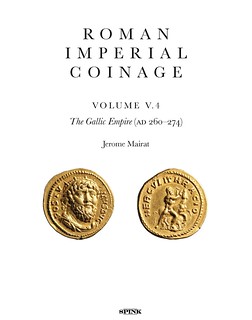 The winner is Jerome Mairat, curator of Roman Coins at the Ashmolean Museum, Oxford, England, for his Roman Imperial Coinage, vol. V.4: The Gallic Empire (AD 260-274), published by Spink in London. Second prize went to Cori Sedwick Downing, a senior numismatist at the house of Daniel Frank Sedwick in Winter Park, Florida, and Isaac Rudman, a collector from the Dominican Republic, for their The Charles & Joanna Silver Coinage of Santo Domingo, 1542-1552, published by Isaac Rudman in Santo Domingo. Third prize went to Glenn Murray, the Spanish-domiciled 72-year old Los Angeles-born numismatist, for his Boato y Tecnología: Cincuentines, centenes y escudos de a echo, published by the Asociación Amigos de la Casa de la Moneda de Segovia, in Segovia, Spain.
The winner is Jerome Mairat, curator of Roman Coins at the Ashmolean Museum, Oxford, England, for his Roman Imperial Coinage, vol. V.4: The Gallic Empire (AD 260-274), published by Spink in London. Second prize went to Cori Sedwick Downing, a senior numismatist at the house of Daniel Frank Sedwick in Winter Park, Florida, and Isaac Rudman, a collector from the Dominican Republic, for their The Charles & Joanna Silver Coinage of Santo Domingo, 1542-1552, published by Isaac Rudman in Santo Domingo. Third prize went to Glenn Murray, the Spanish-domiciled 72-year old Los Angeles-born numismatist, for his Boato y Tecnología: Cincuentines, centenes y escudos de a echo, published by the Asociación Amigos de la Casa de la Moneda de Segovia, in Segovia, Spain.
The value of the Prize is 1,000 CHF. The winner also receives a diploma and an IAPN medal, and it is hoped that these can be presented to him at a future IAPN function."
Here's the complete list of 2024 IAPN Book Prize nominations. Some of these escaped our attention this year, but most were announced here in The E-Sylum. See the linked articles for more information. A great year for numismatic book publishing! -Editor
AAMLID, Jan Olav. Siam Specimen Banknotes: Second Series
House of Coins, Pattaya, Thailand, 2023
ISBN 978-6-165986-65-6
Price: GBP 55, casebound. Order from www.spinkbooks.com
BARKER, Graham, and MOORHEAD, Sam. The Rebel Emperors of
Britannia: Carausius and Allectus
Spink, London, England, 2023
ISBN 978-1-912667-91-8
Price: GBP 30. Order from www.spinkbooks.com
BLAND, Roger. The Coinages of Gordian III from the Mints of Antioch and
Caesarea
Royal Numismatic Society, London, England, 2023
ISBN 978-0-901405-39-5
Price: GBP 80. Order from www.spinkbooks.com
BONNEAU, Laurent. Monnaies Françaises Euro 1992-2022
Éditions Victor Gadoury, Monaco, 2023
ISBN 978-2-906602-55-7
Price: €59. Order from www.gadoury.com
BRUYER, Nicholas. U.S. Treasury Notes 1812-1865 An Illustrated History
Stack's Bowers Galleries, Costa Mesa, CA, USA, 2023
ISBN 979-8-218957-08-7
Price: US $59.95. Order from www.amazon.com
BULL, Maurice. Charles I Oxford Mint Half-Crowns (1642-1646)
Spink, London, 2023
ISBN 978-1-912667-93-2
Price: GBP 100. Order from www.spinkbooks.com
FÉLICE-RUTTLEY, Matthew de. Johann-Baptist Frener: Life & Works 1821-92
International Fine Objects Publishing, New York, USA, 2023
ISBN 979-8-988853-10-7
Price: US $65. Order from www.ifobjects.com
GARCIA, Roberto Menchaca. History of the Coin Circulation in Cuba
Punto Rojo Libros, Seville, Spain, 2023
ISBN 978-8419429-61-2
Price: €19.95. Order from www.casadelibro.com
GITLER, Haim, LORBER, Catherine and FONTANILLE, Jean-Philippe. The
Yehud Coinage: A Study and Die Classification of the Provincial Silver
Coinage of Judah
Israel Numismatic Society, Jerusalem, Israel, 2023
ISBN 978-9-655982-29-9
Price: US $150. Order from www.isdistribution.com
GREGORY, Raymond and Carol. Numismatic History of Canada and the
United States. 2 volumes.
Raymond and Carol Gregory, Alliston, ONT, Canada, 2023
ISBN 978-1-778223-00-6
Price: CAN $189.95. Order from www.numismaticpublishing.com
JONES, Peter. Beautiful Banknotes of France
Bookbaby [US online self-publisher], 2023
ISBN 978-1-667886-10-7
Price: US $49.99. Order from www.store.bookbaby.com
KUNZMANN, Ruedi. Schweizer Konsumgeld, Biermarken und Milchmarken-
Nachträge, Schweizer Trammarken
Battenberg Verlag, Regenstauf, Germany, 2023
ISBN 978-3-866462-42-7
Price: €49.90. Order from www.battenberg-gietl.de
LACOURT, Jean. Sesterces des Antonins (96-192), vol. IV...139...169
Jean Lacourt, Igé, Burgundy, France, 2023
ISBN 978-2-958152-83-3
Price: €69. Order from www.cgbfr.com
MAIRAT, Jerome. Roman Imperial Coinage, vol. V.4: The Gallic Empire (AD
260-274)
Spink, London, England, 2023
ISBN 978-1-912667-99-4
Price: GBP 150. Order from www.spinkbooks.com
MURRAY, Glenn. Boato y Tecnología: Cincuentines, centenes y escudos de a ocho.
Asociación Amigos de la Casa de la Moneda de Segovia, Segovia, Spain, 2023
ISBN 978-8-409484-22-5
Price: €85, casebound. Order from www.aureo.com
PRAVILOVA, Ekaterina. The Ruble: A Political History
Oxford University Press, New York, USA, 2023
ISBN 978-0-197663-71-4
Price: US $39.95. Order from www.global.oup.com
SEDWICK DOWNING, Cori, and RUDMAN, Isaac. The Charles & Joanna
Silver Coinage of Santo Domingo, 1542-1552
Isaac Rudman, Santo Domingo, Dominican Republic, 2023
ISBN 978-9-945911-74-9
Price: US $65. Order from www.sedwickcoins.com
SHEVLIN, Jeff, and HYDER, William. So-Called Dollars, Volume 1: United
States Expositions
So-Called Books, Carmichael, CA, USA, 2023
ISBN 979-8-218950-40-8
Price: US $59.95. Order from www.so-calleddollar.com
STOLYARIK, Elena, and KLEEBERG, John. Scythians and Greeks on the
Western Black Sea: The Coinage of the Kings of Scythia Minor in Dobruja,
218/212–110 BCE
American Numismatic Society, New York, NY, USA, 2023
ISBN 978-0-897224-06-2
Price: US $150. Order from www.numislit.com
VARGAS, Ricardo. Enciclopedia Numismatica de Michoacan, vol. I: Monedas
Municipales
Ricardo Vargas, Guadalajara, Mexico, 2023
No ISBN
Price: US $125. Order from www.worldnumismatics.com
WALLENBROCK, Mark. Three Centuries of Silver: Art and the Coins of
Syracuse
Kindle Direct Publishing, Columbia, SC, USA, 2023
ISBN 979-8-218233-33-4
Price: US $55. Order from www.amazon.com
WITHERS, Paul and Bente. The Galata Guide to Small Change: Silver
farthings, halfpennies and three-farthings 1279-1660
Galata Print Ltd, Llanfyllin, Wales, 2023
ISBN 978-1-908715-22-7
Price: GBP 60. Order from www.galata.co.uk
WRIGHT, Timothy. British Celtic Coins: Art or Imitation?
Spink, London, England, 2023
ISBN 978-1-912667-98-7
Price: GBP 30. Order from www.spinkbooks.com
For more information on IAPN, see:
https://iapn-coins.org/
To read the earlier E-Sylum articles, see:
NEW BOOK: REBEL EMPERORS OF BRITANNIA
(https://www.coinbooks.org/v26/esylum_v26n19a03.html)
NEW BOOK: THE COINAGE OF GORDIAN III
(https://www.coinbooks.org/v26/esylum_v26n25a04.html)
NEW BOOK: MONNAIES EURO FRANCAISES 2023
(https://www.coinbooks.org/v26/esylum_v26n50a04.html)
NEW BOOK: U.S. TREASURY NOTES, 1812-1865
(https://www.coinbooks.org/v26/esylum_v26n30a05.html)
NEW BOOK: CHARLES I OXFORD MINT HALF-CROWNS
(https://www.coinbooks.org/v26/esylum_v26n39a04.html)
NEW BOOK: JOHANN-BAPTIST FRENER
(https://www.coinbooks.org/v26/esylum_v26n32a06.html)
NEW BOOK: HISTORY OF THE COIN CIRCULATION IN CUBA
(https://www.coinbooks.org/v26/esylum_v26n20a04.html)
NEW BOOK: THE YEHUD COINAGE
(https://www.coinbooks.org/v27/esylum_v27n13a04.html)
NEW BOOK: NUMISMATIC HISTORY OF CANADA AND U.S.
(https://www.coinbooks.org/v26/esylum_v26n05a04.html)
NEW BOOK: BEAUTIFUL BANKNOTES OF FRANCE
(https://www.coinbooks.org/v26/esylum_v26n03a03.html)
NEW BOOK: SWISS TOKENS
(https://www.coinbooks.org/v26/esylum_v26n31a05.html)
NEW BOOK: SESTERCES DES ANTONINS - IV (96-192)
(https://www.coinbooks.org/v26/esylum_v26n49a04.html)
NEW BOOK: ROMAN IMPERIAL COINAGE V.4 GALLIC EMPIRE
(https://www.coinbooks.org/v26/esylum_v26n51a02.html)
NEW BOOK: THE RUBLE
(https://www.coinbooks.org/v26/esylum_v26n32a07.html)
NEW BOOK: SCYTHIANS AND GREEKS
(https://www.coinbooks.org/v26/esylum_v26n36a05.html)
MAY 2024 NNP SYMPOSIUM VIDEOS AVAILABLE
The latest additions to the Newman Numismatic Portal are videos recorded at the May 2024 NNP Symposium. Project Coordinator Len Augsburger provided the following report. -Editor
Newman Portal Symposium Video Available
Presentations from the Newman Portal Symposium held May 2-4, 2024 are now available online. Our feature video for this event, produced by Numismatic Marketing, is "Benjamin Franklin and Numismatics." This piece explores Franklin's connections with early American coins, medals, and paper money. Following the video is an appearance by Franklin himself, in the person of Patrick McBride. Additional presentations, by Farley Grubb and Khachatur Manykyan, further explore Franklin's numismatic contributions during the formative years of the United States. A total of eighteen sessions from this event, held in conjunction with the Central States Numismatic Society 2024 convention, are now posted at the link noted.
Image: Libertas Americana medal, designed under the direction of Benjamin Franklin. Paris Mint restrike in gold, 2004. Image courtesy of Heritage Auctions.
Link to Spring 2024 Newman Portal Symposium sessions on YouTube:
https://www.youtube.com/playlist?list=PLDk2lseZ-iyp_VWe9xObGonZUMs9kghMU
Here's a list of the session titles - use the link above to access them. Great selection of topics! -Editor
- Why Boggs? Why Now?
- Early Iowa Coin & Currency
- Contemporary Counterfeit Confederate Paper Money
- Running a Successful Coin Club: Part 2
- Liberty Seated Collectors Club: "Did Gobrecht Use a Shared Punch for No Stars Dimes and Half Dimes?"
- Multiscale Scientific Analysis of Benjamin Franklin's Innovations in American Paper Money
- German Notgeld: The World's First Banknote Collecting Craze
- Antisemitic Notgeld and Weimar Antisemitism: Numismatics and the Rise of Nazi Ideology
- What Happened in Holland?
- The Current Numismatic Market
- Things to See at the Higgins Museum of National Bank Notes
- Benjamin Franklin and Numismatics
- The Origins of the Continental Dollar, 1775-1776: Congressional Deliberations and Decisions
- Lady Liberty, Real or Ideal?
- Iowa Numismatic Association: Past and Present
- The Coin Show Podcast Presents: Tales from Over the Counter
- North American Medals of the French and Indian War
- "Technical Grading" vs. "Market Grading"
NEWMAN GRANTS 2024 AWARD ANNOUNCEMENT
Len Augsburger provided this announcement of the 2024 Newman Grants on May 25th, the birthday of the late Eric P. Newman. Some great projects outlined here. -Editor
Eric P. Newman Numismatic Education Society Announces Newman Grants
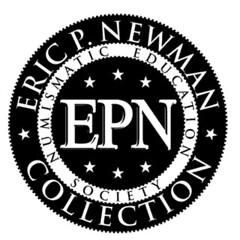 The Eric P. Newman Numismatic Education Society (EPNNES) today announces its fifth set of Newman Grants, created to financially assist numismatic authors and organizations pursuing original research in American and world numismatics. Newman Grants are awarded annually on the late Eric P. Newman's birthday and assist with direct costs of numismatic research such as travel, photography, and graphic arts services.
The Eric P. Newman Numismatic Education Society (EPNNES) today announces its fifth set of Newman Grants, created to financially assist numismatic authors and organizations pursuing original research in American and world numismatics. Newman Grants are awarded annually on the late Eric P. Newman's birthday and assist with direct costs of numismatic research such as travel, photography, and graphic arts services.
Five awards are being made this year, touching on varied numismatic topics. The 2024 Newman Grant awardees are as follows:
Steve and Ray Feller, and Katie Ameku will explore United States World War II camp monies, with a focus on Italian and German civilian internees, both citizens and aliens.
Harcourt Fuller will produce a documentary short film on the movement to depict the African-American abolitionist, Civil War nurse, and spy Harriet Tubman (1822 – 1913) on the $20 bill.
Liesel Gentelli will expand upon her previous work related to the compositional analysis of coinage produced by the Spanish American colonial mints.
Daniel Harmelink will create an annotated English version of Christian Schlegel's coin and medal descriptions as published in the 1719 German reference, Hilaria Evangelica.
Tom Sparks will research the Major General Clayton L. Bissell World War II short snorter, which consists of 140 world banknotes signed by numerous dignitaries including generals, ambassadors, presidents, and prime ministers.
It is the hope of EPNNES that this program will continue the legacy of Eric P. Newman in a way that would reflect his high standards for numismatic research.
To read the earlier E-Sylum article, see:
2024 NEWMAN GRANT PROGRAM ANNOUNCED
(https://www.coinbooks.org/v27/esylum_v27n04a10.html)
VIDEO: HISTORY OF WELLS FARGO
The David Lisot Video Library on the Newman Numismatic Portal can be found at:
https://nnp.wustl.edu/library/multimediadetail/522852
We highlight one of his videos each week in The E-Sylum. Here's one from 2005 with Robert J. Chandler speaking about the History of Wells Fargo -Editor
An illustrated history of the legendary company with an emphasis on numismatics. You will see and learn about:
- The discovery of gold in California that created the need for coinage
- Efforts by private issuers and the government to create a uniform coinage
- Formation of American Express in 1850 that included Wells & Fargo
- How gold started as dust and ended up as money
- Examples of paper drafts, stock certificates, checks and other monetary instruments that are now collectible
- Why Federal paper money was not accepted in California
- Importance of steam ships to get to California
- The Wells Fargo mail system including the Pony Express and use of stage coaches
- Buyouts, mergers, corporate raiders, completion of the railroad
- Emperor Norton, gold-backed national bank notes and more

Speaker: Robert J. Chandler. Publication date: 8/20/2005.
To watch the complete video, see:
History of Wells Fargo
(https://youtu.be/XaAtV4V8c1U)
2024 PNG AWARDS NOMINATIONS NOW OPEN
E-Sylum readers and contributors are stalwarts of the numismatic community. Consider nominating them or their works for the 2024 PNG Awards. -Editor
 The Professional Numismatists Guild is now accepting nominations for its 2024 awards, according to PNG Executive Director John Feigenbaum.
The Professional Numismatists Guild is now accepting nominations for its 2024 awards, according to PNG Executive Director John Feigenbaum.
The PNG publicly recognizes outstanding achievements in the hobby and the profession by honoring deserving recipients with prestigious awards. We cordially welcome and strongly encourage nominations from all collectors and dealers,
said Feigenbaum.
The award winners will be announced on August 6 during a PNG cocktail reception at the American Numismatic Association Chicago Worlds' Fair of Money in Rosemont, Illinois,
explained PNG President and Awards Committee Chairman James Sego.
All award entries and nominations must be submitted by June 21, 2024. Except for the Friedberg book award entries, all nominations should be sent by email to PNG Executive Assistant Tina Bellanca at info@PNGdealers.org. See the information below on where to submit the book entries.
The award categories are:
Abe Kosoff Founders Award: Presented to a PNG member-dealer with steadfast dedication to the entire numismatic community and who has made a significant contribution to the Guild or to the numismatic fraternity. The award is named after PNG's Founding President who spearheaded the 1953 launch of the organization.
Sol Kaplan Award: To recognize efforts and contributions in combating crimes against the numismatic community, this award is presented to someone who has given their time to rid the profession of fraud and thievery. The Kaplan Award is named after a former PNG President and Ohio dealer who was personally responsible for the apprehension of several people suspected of committing numismatic-related crimes.
Robert Friedberg Award: Presented to an author in recognition for an outstanding book or other literature. Named in honor of a publisher and author of numismatic reference books, this award is not automatically given each year. It is only given when there is deemed to be a worthy recipient or recipients. A copy of each book entry should be sent to Wayde Milas, c/o RARCOA, 7550 S. Quincy St., Willowbrook, Illinois 60527.
Harvey G. Stack Lifetime Achievement Award: Presented to a numismatist for his/her extraordinary devotion to numismatics and who, over their lifetime, significantly contributed to the hobby or profession.
Significant Contribution Award: Given to those who have made exceptional, beneficial efforts over the years on behalf of PNG and the profession, and also added to the hobby.
Art Kagin Ambassador Award: This award is named after a former PNG President and nationally-known Iowa dealer who provided distinguished service as an advocate of numismatic goodwill.
The PNG is a nonprofit organization composed of many of the top rare coin and paper money dealers in the United States and four other countries. PNG member-dealers must adhere to a strict Code of Ethics (www.PNGdealers.org/code-of-ethics) in the buying and selling of numismatic merchandise.
Authors and publishers - consider entering your book for the Robert Friedberg Award. -Editor
For additional information about PNG, visit online at www.PNGdealers.org or call (951) 587-8300.
For more information on the Professional Numismatists Guild, see:
https://www.pngdealers.org/
MORE ON EARLIER BRUUN COLLECTION SALES
David Tripp submitted these notes on the disposition of the first groups of coins sold from the Bruun collection. Thank you! See the article elsewhere in this issue for details on Part I of the Stack's Bowers Bruun sales. -Editor
As ever, the E-Sylum begins my week with stimulation. My thanks.
First, on my great old friend and colleague David Redden. Personally and professionally, simply irreplaceable.
Your Bruun collection query tweaked something in me, since when I working on the Brand sales in the 1980s there were a few Scandinavian coins (extremely good ones) and Bruun was the source of most.
 Brand 1: Denmark, lots 160-163 (3 ex Bruun); Sweden, lots 281-295 (14 ex Bruun)
Brand 1: Denmark, lots 160-163 (3 ex Bruun); Sweden, lots 281-295 (14 ex Bruun)
Brand 4: Sweden, lots 314-318 (all 5 ex Bruun)
You will see some of these lots are noted as coming from Schulman privately (27 September 1921), these are, in fact, Bruun, see below.
I did a quick search Wednesday morning. Here are L.E. Bruun auctions I have found.
1). Adolph Hess, 18 May 1914
2). Adolph Hess, 26-27 October 1914 (cancelled, but the catalogue was written): https://digi.ub.uni-heidelberg.de/diglit/hess_nachf1914_10_26bd2/0107/image,info,thumbs
3). Sotheby's, 18-22 May 1925 (British, Saxon and English, etc.)
4). Sotheby's, 25 May 1925 (Continental coins and medals, etc.)
5). Holger Hede, 12 October 1925 (Vast, I haven't found the catalogue online, but see the ANS entry): https://donum.numismatics.org/cgi-bin/koha/opac-detail.pl?biblionumber=124587 (Brand bought some 140 lots, primarily Danish)
As to your question as to what happened to the cancelled sale coins. According to the introduction to the first Sotheby's sale, the second portion of the Hess sale was sold privately during the War
.
The ultimate purchaser was Virgil Brand from Schulman on 27 September 1921 (VMB 112,686-114,588). He paid, according to the ledger, almost $43,000.
(Compare this with the $100,000 paid in 1942 by Louis Eliasberg for the Clapp Collection and the $100,000 John Garrett and Wayte Raymond paid for the Ellsworth Collection in 1923).
Here is a screen shot from Brand ledger 18 with the purchase info (the listing spills into the following ledger).
To read the earlier E-Sylum article, see:
DAVID NORMAND REDDEN (1949-2024)
(https://www.coinbooks.org/v27/esylum_v27n20a06.html)
THE BRUUN COLLECTION GETS COVERAGE
(https://www.coinbooks.org/v27/esylum_v27n20a22.html)
NOTES FROM E-SYLUM READERS: MAY 26, 2024
Happy For The Help
Gerry Tebben writes:
 "Congrats on getting an assist from Garrett Ziss. I've been amazed at what you've been able to do by yourself over the years."
"Congrats on getting an assist from Garrett Ziss. I've been amazed at what you've been able to do by yourself over the years."
Julia Casey writes:
"Not that you weren't juggling it all splendidly, Ye Maestro Nummorum, but I'm glad (for you) that you will be getting some assistance with the burgeoning Goliath that is our beloved E-Sylum."
Thanks - I'm very glad to have Garrett aboard; he assisted with several articles this week. -Editor
Adrián González-Salinas writes:
"I'm glad that you can have the support of Garrett Ziss in the weekly edition of The E-Sylum. Welcome aboard Garrett!
"For many years, I have wondered how Wayne K. Homren reads, proofreads and edits the articles submitted by readers of The E-Sylum every week and then distributes this publication in a timely manner with better-than-atomic-clock punctuality from Fort Collins, Colorado. The conclusion I have come to is that Wayne has a Personal Time Tunnel such that when he starts editing The E-Sylum he transports himself into his Tunnel so that time stands still and when he finishes editing and distributing it only a few nanoseconds have passed on Earth. In short, I can't imagine how Wayne has time to do all these activities as Editor of The E-Sylum!!!!
"As usual, many congratulations to Wayne Homren."
Drat, my secret's out. Thanks for the image, but it's making me dizzy. Wait here while I go buy some more Nvidia stock two years ago. -Editor
To read the earlier E-Sylum article, see:
GARRETT ZISS TO ASSIST E-SYLUM EDITOR
(https://www.coinbooks.org/v27/esylum_v27n20a02.html)
Why Do So Many Latin American, Spanish & Filipino Coins Have Holes?
Ken Berger writes:
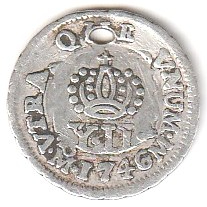 "This is practiced in many Spanish, Latin American & Philippine Catholic wedding ceremonies.
"This is practiced in many Spanish, Latin American & Philippine Catholic wedding ceremonies.
"The groom gives 13 coins (the arras) to the bride, symbolizing his ability to support & care for her. The 13 coins represent Jesus & the 12 Apostles. The coins are "dribbled" into the bride's hands like "flowing water". If any of the coins fall & miss her hand, the marriage is believed to be doomed. So to prevent this, the coins had a hole drilled into each one & they are tied together so that they may "flow" nicely into her hands."
Cool - thanks! -Editor
For more information, see:
https://en.wikipedia.org/wiki/Las_arras
To read the earlier E-Sylum article, see:
NOTES FROM E-SYLUM READERS: MAY 19, 2024 : More Holed Coins
(https://www.coinbooks.org/v27/esylum_v27n20a11.html)
The First Boy Scouts of America Troop
Jim Haas writes:
 "Most especially did I enjoy seeing Gary Oddie's Boy Scout button; there is always a College Point connection.
"Most especially did I enjoy seeing Gary Oddie's Boy Scout button; there is always a College Point connection.
"Daniel Carter Beard was born in Cincinnati on June 21, 1850 and died on June 11, 1941, ten days shy of his 91st birthday. Throughout his long life he was an engineer, an artist, an author and the founder of the Boy Scouts of America in 1910 in Flushing, Queens, NY. Troop Number 1 was unofficially recognized as being the first Troop ever formed.
"However, two decades later in mid-March 20, 1930 that status was challenged by the Scout Master of Troop 2 in my hometown, College Point, a small village north of Flushing. On that day the local press reported that the honor actually belonged to Troop 2, its Scoutmaster being John G. Embree, also the Principal of College Point's Poppenhusen Institute. The organization of the Troop was fixed at August 8, 1910 based on a scoutmaster's report and re-registration form signed on March 23, 1914. Queens Headquarters said that its records of the College Point Troop were very vague, but an earlier newspaper notice report dated August 6, 1910 backs up the assertion.
"Rudolph Zwicke, born in 1885, was scoutmaster at the time. He stayed at his post until 1960. While I was in a different troop, I was well aware of Mr. Zwicke who marched in front of his Troop 2 scouts in the community's annual Memorial Day parade. He died in 1978."
To read the earlier E-Sylum article, see:
NOTES FROM E-SYLUM READERS: MAY 12, 2024 : Charity Donation Badges
(https://www.coinbooks.org/v27/esylum_v27n19a10.html)
More on Numi Grading Performance
Responding to Justin Hinh, Bill Eckberg writes:
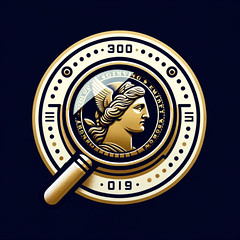 "I finally had enough time to go over the numbers from the newest dataset.
"I finally had enough time to go over the numbers from the newest dataset.
"It seems to me that the program has trouble with the grades of F-AU. Lots of variations, and I wouldn't say from the data that any particular number of photos makes a difference. There is no statistical way that using more photos should give worse consistency like you see with the 40 coin.
"The program is pretty close on G-VG coins, but I wonder if that might be some kind of artifact, with XF coins also being graded as G-VG.
"As to the UNC coins, the difference between 65 and 66 is something that I can't always tell. Ditto for 69 and 70, and I don't think the latter two grades have any meaningful difference. They are just the whim of whoever graded the coin, and the ego of the collector who spends for them. Your program would seem to agree. Fortunately, you picked ultra high-grade coins that didn't cost a lot. Sometimes the premium for that insignificant little upgrade is very significant.
"I admit that I'm a dinosaur. I never buy the coin at the grade on the slab unless I understand and agree with it."
To read the earlier E-Sylum article, see:
REVISITING NUMI, PART TWO
(https://www.coinbooks.org/v27/esylum_v27n20a10.html)
Collecting Uncashed U.S. Treasury Checks
Kavan Ratnatunga of Sri Lanka writes:
"Back in 2021 April, I asked for US$12 as a Tax Refund check to put it in my collection without depositing.
"A year later I got a replacement check which I also kept.
"The next year I got a letter dated 2023 August 28th which said I needed to call them before they could send a replacement. So I thought it was the end of the story when I did not call.
"To my surprise yesterday I got another replacement check dated 2024 March 15th and posted by registered mail to me from the US Embassy in Sri Lanka on 2024 May 17th. The letter also contained a set of forms to apply for direct deposit to a Sri Lankan Bank. :-).
"This may be because a friend of mine found it difficult to deposit US Treasury checks to any local bank as they have no corresponding bank. He finally had to open an account with HSBC which is an international Bank.
"I have safely kept all the checks and envelopes. Even the envelopes from the US Embassy in Sri Lanka and associated content."
I'm impressed with the perseverance of both Kavan and the U.S. Treasury. Nice little collection he's got there. -Editor
To read the earlier E-Sylum articles, see:
NOTES FROM E-SYLUM READERS: AUGUST 1, 2021 : Collecting U.S. Treasury Checks
(https://www.coinbooks.org/v24/esylum_v24n31a16.html)
NOTES FROM E-SYLUM READERS: JULY 31, 2022 : Uncle Sam's Free Numismatic Collectibles
(https://www.coinbooks.org/v25/esylum_v25n31a09.html)
A Buick Encased Silver Dollar
Website visitor and new subscriber Jim Turner passed along these images of a Buick encased silver dollar. Thanks. See the earlier articles linked below for more information. -Editor
Jim adds:
"I received it from elderly man for helping him sell his collection. I was glad I have it."
To read the earlier E-Sylum article, see:
QUERY: BUICK, GENERAL MOTORS ENCASED DOLLARS
(https://www.coinbooks.org/v21/esylum_v21n05a20.html)
NOTES FROM E-SYLUM READERS: FEBRUARY 11, 2018 : Buick Encased Dime
(https://www.coinbooks.org/v21/esylum_v21n06a13.html)
The BEP Single Note Inspection System
Kavan Ratnatunga writes:
 "When I took a tour of the Bureau of Engraving and Printing (BEP) in Fort Worth Texas in 2024-April, I was able to see the Single Note Inspection Machine (SNIM), from the skywalk. They said that part of the tour had been closed for public view till recently. When I asked for details I was told that all of the rejected sheets were recycled, printed with Serial numbers and those notes alone were subject to SNIM and the good notes accepted. Those Uncirculated bundles I understand will not have *-notes and the serial numbers will have gaps in the sequence. Is my understanding correct?
"When I took a tour of the Bureau of Engraving and Printing (BEP) in Fort Worth Texas in 2024-April, I was able to see the Single Note Inspection Machine (SNIM), from the skywalk. They said that part of the tour had been closed for public view till recently. When I asked for details I was told that all of the rejected sheets were recycled, printed with Serial numbers and those notes alone were subject to SNIM and the good notes accepted. Those Uncirculated bundles I understand will not have *-notes and the serial numbers will have gaps in the sequence. Is my understanding correct?
"DeLaRue in Sri Lanka which has done away with Replacement *-notes, does not precheck the printed sheets, and all notes are printed with serials and then subject to SNIM. Maybe that is practical for small print orders, where the number of notes printed is relatively small, but not for the USA"
Can anyone answer Kavan's question? -Editor
To read the complete article, see:
BEP reports Single Note Inspection system prevents millions in waste
(https://www.coinworld.com/news/paper-money/bep-reports-single-note-inspection-system-prevents-millions-in-waste)
Unusual Labeling on DANSCO Kennedy Half Page
Ken Barr writes:
"I came across an early DANSCO #7166 Kennedy Half Dollar album (without proofs) page -- only seven labeled ports.
"Oddly, the 1964-D port is labeled BEFORE the 1964 (Philadelphia) port, something I've never seen before.
"Might be worthy of asking the E-Sylum readers if this is Something of Great Importance or just a Whatever! ..."
Justin Hinh writes:
"Hmm, the oddest thing is that the D is listed before the P. By the mid/late sixties, almost all coin album manufacturers had already switched to the PD/PDS format. I haven't seen a misprint like this before.
"Given the label and texture of the page, the album was printed in the mid/late sixties.
"This is simply a misprinted Dansco page. It's very rare to come across them, but they occasionally pop up. It is not particularly valuable. More of a hassle than anything else!"
1930's Chinese Documents Sought
Michael Zachary writes:
"I am the author of The Ten Cash Commentary
and the Twenty Cash Commentary,
which are guides to the general issue 10 and 20 cash coins of the early Republic of China (both books available on Amazon).
"I am writing a new book, which includes a chapter on some of the coins of the Chinese Soviets, circa 1931-34. I am hoping your readers can help me with a research problem. I've been looking for two financial/monetary-related documents:
-
A December 1, 1931 document, issued by the First National Congress of the Chinese Worker-Peasant-Soldier Soviet (AKA, the 1931 Chinese Soviet Congress), entitled
Economic Policy of the Chinese Soviet Republic.
I have an English-language version of this document, but not a Chinese-language version (to help ensure the English version is accurate). While I am primarily looking for a Chinese-language version, I also would be interested in seeing if other English versions are consistent with the one I have. -
A December 9, 1932 document entitled,
Report on the Specific Situation in Western Hunan and Hubei.
I do not know who issued this report, but it is mentioned in a 2002 article by Zhang Yigang in the Chinese-language periodical, Chinese Numismatics. I would be happy to receive either a Chinese- or English-language version.
Thanks in advance for your help."
Well, if anyone can assist, it's probably an E-Sylum reader. Can anyone help? -Editor
ROMA NUMISMATICS CEASES OPERATIONS
In the continued fallout over two rare ancient coins sold at auction in 2020 with falsified provenances, Roma Numismatics Limited, has ceased operations. Owner Richard Beale had been arrested and later admitted buying false ownership history documents for both coins. -Editor
To visit the Roma Numismatics website (while it lasts...), see:
https://www.romanumismatics.com/
To read the an Antiques Trade Gazette article (subscription required), see:
Roma Numismatics to close doors this week
(https://www.antiquestradegazette.com/news/2024/roma-numismatics-to-close-doors-this-week/)
To read the complete article, see:
Roma Numismatics to Close on 24-May 2024
(https://new.coinsweekly.com/news-en/roma-numismatics-to-close-on-24-may-2024/)
To read the earlier E-Sylum article, see:
RICHARD BEALE OF ROMA NUMISMATICS ARRESTED
(https://www.coinbooks.org/v26/esylum_v26n11a16.html)
BEALE ADMITS FALSIFYING COIN PROVENANCES
(https://www.coinbooks.org/v26/esylum_v26n35a13.html)
OWEN LINZMAYER JOINS CDN PUBLISHING
Banknote Book editor Owen Linzmayer has joined CDN Publishing as Product Manager to oversee the massive catalog of world paper money. -Editor
On the 13th anniversary of publishing The Banknote Book (BNB), CDN Publishing is pleased to announce that its editor, Owen W. Linzmayer, has recently been hired as the Product Manager to oversee the most comprehensive catalog of world paper money in existence. Linzmayer has extensive experience writing for national computer magazines, has authored many technology books including the best-selling Apple Confidential, and served as the editor of the International Bank Note Society Journal.
In 2011, Linzmayer began publishing The Banknote Book with an initial release of 10 country-specific chapters. From these humble beginnings, the catalog has swelled to over 320 chapters (and growing), with more than 9,600 pages covering almost 100,000 types and varieties, with a steady stream of new material and revisions released every week. Available in digital form via subscription on greysheet.com, The Banknote Book is now widely regarded as the new standard reference for the hobby, and a must-have for all serious collectors and dealers of paper money.
 In 2021, after a decade of self-publishing, The Banknote Book was acquired by CDN Publishing, long-time publisher of the Greysheet and Greensheet, the definitive pricing newsletters for United States coins and currency, respectively. Linzmayer has remained actively involved as editor of the catalog post-acquisition, and now as a full-time employee, Linzmayer can focus his passion and talents towards the enormous task of cataloging the entire history of international banknotes.
In 2021, after a decade of self-publishing, The Banknote Book was acquired by CDN Publishing, long-time publisher of the Greysheet and Greensheet, the definitive pricing newsletters for United States coins and currency, respectively. Linzmayer has remained actively involved as editor of the catalog post-acquisition, and now as a full-time employee, Linzmayer can focus his passion and talents towards the enormous task of cataloging the entire history of international banknotes.
Last November, CDN Publishing acquired the historic Whitman Publishing, combining CDN's pricing and data strengths of Greysheet, Greensheet, and The Banknote Book with Whitman's numismatic power-house publication lineup of Red Book, Blue Book, Red Book Series, Cherrypicker's Guide, 100 Greatest, and more, offering a comprehensive and intellectually rich coverage of collectibles, and thus creating significant growth opportunities. The combined companies have been rebranded as Whitman Brands.
The recent acquisition of Whitman opens up exciting new possibilities for improving The Banknote Book even further,
says Linzmayer. As an employee, I join a staff that has a proven track record of providing essential tools and reference materials to the broader numismatic community. I look forward to working with the staff and our large network of avid contributors to continue improving the catalog with accurate, detailed information that adds value to all subscribers around the world.
To view and subscribe to The Banknote Book, see: https://www.greysheet.com/world-paper-money-prices .
To read the complete article, see:
Long-time Banknote Book (BNB) Editor Owen Linzmayer Joins The CDN Publishing Team
(https://www.greysheet.com/news/story/long-time-banknote-book-bnb-editor-owen-linzmayer-joins-the-cdn-publishing-team)
VOCABULARY TERM: PLASTER CASTING
Here's another entry from Dick Johnson's Encyclopedia of Coin and Medal Terminology. -Editor
Plaster Casting. Preparing a three-dimensional cast for a more permanent, transferable, reproducible form in plaster of Paris. Plaster casting requires a craftsman skilled in preparing the model, mixing the plaster with water, pouring the plaster and removing air bubbles. Plaster casting is easy to learn and proficiency comes early, but there are many variables – kinds of plaster, time, temperature, release agents – in addition to the caster's skill. While some of these variables are the operator's choice, as hard or soft plaster, the use dictates others. For example, a super fine hard plaster is preferred in the coin and medal field but the caster may prefer one brand over another. Hydrocal and Densite are brands of commercial plaster used in the modeling of coins and medals.
Preparing the model. The original model can be any medium the modeler worked in – clay, plasteline, wax, plaster, wood, metal, whatever. This needs to be transformed into a more permanent, three-dimensional form and plaster is the best medium for accomplishing this. The original model, in most instances, may be porous or rough. So the first step is to smooth the surface of the model with steel wool, emery, fine sandpaper or light rubbing.
Second step is a sealer. Brush the model with a very light coating of shellac. If the brush strokes are visible, then too much has been applied. If the model is white plaster, the caster may wish to use a tinted shellac (to make it different from the casting). An orange shellac, diluted 3 or 4 to 1 and will give a reddish tint to the coating applied to the model. Allow ample time for the shellac to dry, and no longer be tacky.
Third step is a release agent. Clay or plasteline models generally do not need a release agent when cast in plaster, every other medium does. Even so, a light dusting of talc on clay will prevent it from sticking in the mold. For a model made of plaster use a very light coating of vegetable oil, or Mazola oil. Talc, liquid green soap or silicon spray can also be used as a release agent on plaster.
Fourth step is to build a fence around the model. This can be of any thin sturdy material, as galvanized tin, lead, or similar. Clay cannot be used for this step because of the weight of the plaster could break through the clay. For plaster casts intended to be pantographically reduced a flange of one to two inches needs to be added to the cast.
Mixing plaster with water. Choose a container for the proper amount of plaster necessary for one entire cast – no more, no less. The container is best if it is flexible (for later cleaning) and have a round bottom. Pour in the water, about 85% of the volume needed; the water may be hot, cold or room temperature. Hot water slightly increases setting time, cold water slightly retards it.
If a harder plaster is required it can be accomplished by substituting lime water for a portion of the tap water.
Pour the dry plaster into the water, letting it sink to the bottom. Keep pouring a little at a time, keeping some plaster on the surface of the water at all time. It will reach a saturation point. Stop adding plaster. The consistency will be fairly fluid – this is ideal.
Insert a large flat spoon for stirring. This is called spatulation. Do not remove the spoon from the mixture. Do not whip, do not do anything to introduce air into the mixture.
Stir the spoon on the bottom of the container with a flat swishing motion. There are mechanical spatulators – these have blades, both at bottom and near the top but must be covered by the liquid. Do not allow any air into the mixture.
The longer time for spatulation, the less time required for setting (one minute stirring requires 10 minutes setting time, two minutes stirring requires 7 minutes setting, and three minutes stirring requires 5 minutes setting time.)
Ideally the caster wants sufficient time to work with the pouring then have the plaster set quickly. The slower the setting time the more skillful must be the caster. However the caster can lessen the setting time by using hotter water and longer spatulation, as mentioned, but he can also do this chemically by adding a hastener (or a hardener to quicken the drying) – or a retarder if the caster wants a slower setting time). Liquid gypsum hardeners and retarders are available commercially.
Pouring the liquid plaster. After the model is smoothed, sealed, dried and coated with a release agent, and the plaster is mixed, the model is given a very fine spray of water from an atomizer bottle. The liquid plaster is poured – only a small amount! – first in the high points (lowest cavities in the model) with this small amount.
With a 100% bristle brush and by blowing almost as hard as a human can, move the liquid plaster around to make certain there are no bubbles and all cavities are filled. Then the caster moves on to other areas like the legend or lettering; blowing and brushing the liquid plaster back and forth until a film of plaster covers every surface.
After all surfaces have been checked for no voids and no air bubbles, then the remainder of the plaster is slowly poured over the model to fill the mold made by the fences. The plaster should be poured to a level about one inch above the highest point of the model.
Setting and drying. All this procedure, of course, has to be accomplished within the three to ten minutes of the setting time. Plaster begins setting as soon as it comes in contact with the water.
Heat will be given off as the plaster dries. It is warm to the hand but the heat diminishes as the drying continues, for up to two hours. When the caster can place his hand on the plaster and it is cool to the touch the casting can be separated from the mold.
Separating the cast from the mold. After the fence is removed a knife is inserted between the cast and the mold at several places around the casting and pried apart. Had the model been properly prepared (with no undercuts) and an adequate release agent used the cast separates easily from the mold.
Lift straight up. Do not tip the casting to either side, but lift straight up. And there is the plaster cast. However dry the mold appears it is not ready for further use; it must be baked.
It must be further dried in an oven at 125° for from 12 to 14 hours. This removes all moisture and gives the plaster its hardness and permanency.
The sculptor may cast his own model, or the caster may be a separate craftsman (specializing in plaster casting). Either way the thoroughly dried plaster cast is then viewed by the artist. The sculptor – despite the amount of time in preparing the original pattern – will undoubtedly want to touchup the cast, sharpening up detail and deepening some areas for greater contrast.
Coloring plasters. The plaster cast will be chalk white. The surface can be tinted (as for photographing), or the plaster can be colored entirely throughout by adding the coloring (as blueing) when it is mixed with water.
To read the complete entry on the Newman Numismatic Portal, see:
Plaster Casting
(https://nnp.wustl.edu/library/dictionarydetail/516504)
To read the earlier E-Sylum article, see:
VOCABULARY TERM: PLASTER CAST
(https://www.coinbooks.org/v27/esylum_v27n20a13.html)
ALFRED EDWARDS EMERSON (1859-1943)
E-Sylum Feature Writer and American Numismatic Biographies author Pete Smith submitted this article on the founder of the Cornell University coin collection, Dr. Alfred Emerson. Thanks! -Editor
I've gotten a little behind with my reading. This week I was reading The Chicago Tribune from March 13, 1913. An article mentioned an old coin found in an Indian mound in Hancock County, Illinois. It had been taken to the Chicago Art Institute for examination by Alfred Emerson.
Dr. Emerson, who is considered one of the nation's greatest numismatists, said he had never seen a coin like it and could only estimate that it had been made in Rome or Greece during the period between 250 B.C. and 250 A.D.
Well, if he was one of the nation's greatest numismatists, I thought I should learn more about him.
Alfred Emerson was born in Greencastle, Pennsylvania, on February 25, 1859, into a family of much accomplishment. He was the son of the Reverend Edwin M. Emerson (1823-1908) and Mary Louisa Ingham Emerson (1829-1883). His father was a lawyer in New Haven, Connecticut. His mother was the daughter of Secretary of the Treasury Samuel Ingham.
The family moved to Europe and settled in Paris in 1863. They travelled extensively and relocated to Germany. Alfred spent a year doing fieldwork in Greece. Alfred received a Ph.D. from the University of Munich in 1880 at age 21. He had fellowships at Princeton University during 1881-1882 and at Johns Hopkins University during 1882-1887.
He was married on July 28, 1887, to Alice Louisa Edwards (1862-1933), a concert pianist with the Boston Symphony Orchestra. They had four accomplished children. Edith Emerson (1888-1981) was an artist and curator at the Woodmere Art Gallery. Gertrude Emerson, (1890-1982) was one of the founding members of the Society of Women Geographers. Willard Ingham Emerson (1894-1966) was a decorated veteran of WWI, vice president at Cornell and investment banker. Alfred Edwards Emerson, Jr, (1896-1976) was a professor of Zoology at the University of Chicago and an authority on termites.
Alfred was a professor of Greek at Miami University in Oxford, Ohio, during 1887-1889. Then he was Professor of Latin at Lake Forrest University during 1889-1891.
Emerson was an Associate Professor of Classical Archaeology at Cornell University from 1891 to 1898. He went on archaeological expeditions to Greece and North Africa. While at Cornell, Emerson began formation of the universities' coin collection with some help from his students. As they claim, Cornell's coin collection is listed among the most important numismatic collections in the United States.
Digital images are now available through the Cornell University Library.
In 1892, Cornell's Museum of Classical Archaeology opened with about 800 plaster casts of classical sculptures, a gift from Henry W. Sage. At the time. Professor Emerson could claim this as the largest collection of its kind. Gradually such exhibits grew out of favor at museums and the Cornell collection has been scattered across campus. Emerson also produced electrotype copies of ancient Greek and Roman coins.
As great a numismatist as he was, his opinion on coins could be controversial. The Washington Herald of March 15, 1913, reported on Emerson's comments.
He declared that it was so old that no coin like it had ever been seen before, and estimated the date of its mintage to be about 250 B.C. This, he declared, brought out the fact that white men, probably of the Roman Empire, had been in America before the Indians.
Other experts politely disagreed with the conclusion of Emerson, They included secretary of the Smithsonian Institution Charles D. Walcutt and Chief of the Bureau of American Ethnology F. W. Hodge.
During World War I and later, he worked as a translator for the Army. He and his wife were with the American Military Mission in Berlin during the early 1920's. They witnessed the hyperinflation in Germany at the time. The Emersons returned to Ithaca, far above Cayuga's Waters.
He suffered a heart attack and died in Chicago on October 19, 1943. He is buried with his father, wife and two children at Thomson Memorial Cemetery in New Hope, Pennsylvania.
 It may be fair to call Emerson a numismatist, but he also studied languages, art, music, sculpture, history, literature, poetry and theater of the ancient cultures. He was a legitimate archaeologist and professor.
It may be fair to call Emerson a numismatist, but he also studied languages, art, music, sculpture, history, literature, poetry and theater of the ancient cultures. He was a legitimate archaeologist and professor.
After reading everything I could about him. I am convinced he was not one of the nation's greatest numismatists. One should not believe everything you read in the papers.
When Emerson stated that he had never seen a coin like it, it is possible that it was a scarce coin. It is also possible that Emerson's experiences were limited. Finally, it is possible that burial damaged the coin beyond recognition.
I have not learned if the original mound find coin was ever identified. I checked Numismatic Notes and Monographs for 2009 and the issue Numismatic finds of the Americas: an inventory of American Coin Hoards. Shipwrecks, single finds, and finds in excavations.
The issue lists nine finds for Illinois but not the coin from Hancock County. This indicates the coin was never attributed and published.
The coin was found by S(anford) W(ebber) LeNeve (1870-1943). After finding the coin, he was one of a dozen founding members of the Kickpoo Club. Their mission was to encourage the protection of the Indian mounds and Indian trails throughout the county, and to spread the interest of such relics of the early history of this part of the state.
ATLAS NUMISMATICS SELECTIONS: MAY 26, 2024
Atlas Numismatics has updated their website with 141 new coins, medals, and tokens at fixed prices. Selections include the following items. -Editor
1078302 | AUSTRALIA. Victoria. (Queen, 1837-1901). 1855-(sy) AV Sovereign. PCGS MS62. Sydney. Edge: Milled. Fillet head. KM 2.
Superb lustrous surfaces; extremely rare in this quality.
Ex. Baldwin's New York Sale IX (January 2005) Lot 232 ($42,500 hammer).
$46,500
To read the complete item description, see:
https://www.atlasnumismatics.com/1078302
1078343 | GERMAN STATES. Bavaria. Maximilian II. MDCCCLII (1852) AV Ducat. NGC MS64? DPL (Deep Prooflike). 3.49gm. MAXIMILIAN II BAVARIAE REX. Head right / River scene. KM 841; Fr.-278; Divo/S.-35; Schl.-114.
The appearance of a lovely proof striking with heavily frosted devices and deeply mirrored fields; given the star designation by NGC for exceptional eye appeal.
$29,500
To read the complete item description, see:
https://www.atlasnumismatics.com/1078343
1078781 | GREAT BRITAIN. England. Anne. (Queen, 1702-1714). 1702 AV Pattern Guinea. NGC AU50. ANNA · DEI · - GRATIA ·. Bust left with no drapery and lovelock on shoulder / MAG - BR FRA - ET · HIB - REG ·. Monogram AR at center; crowned shields in cruciform, sceptres at angles. W&R 59 (R6, 3-5 Known).
An exceedingly rare pattern guinea and quite possibly the first true pattern guinea struck.
Ex. St. James's Auctions Ltd. (London), Auctions 14-15, 30 September 2010, Lot 501. Ex. Captain Douglas-Morris Collection, Sotheby's Sale (26 November 1974) "The Distinguished Collection of English Gold Coins 1700-1900 formed by Captain K. J. Douglas-Morris R.N." Lot No 5; Ex. Captain Vivian Hewitt Collection. Includes original copy of the 1974 Sotheby's Sale catalog with the illustration of this coin (Lot No. 5).
$75,000
To read the complete item description, see:
https://www.atlasnumismatics.com/1078781
1078283 | MEXICO. Charles III. (King, 1759-1788). 1780-Mo FF AR 8 Reales. PCGS AU58. Mexico City. CAROLUS · III · DEI · GRATIA ·. Armored bust of Charles III, right / · HISPAN · ET IND · REX · ... Crowned shield flanked by pillars with banner, normal initials and mint mark. KM 106.2.
$2,450
To read the complete item description, see:
https://www.atlasnumismatics.com/1078283
1078837 | SWISS CANTONS. Basel. ND (1670) AR 2 Thaler. NGC MS62. 56.01gm. DOMINE CONSERVA NOS IN PACE. Coat of arms of Basel surrounded by eight small shields. / BASILEA. City view. Davenport 1741; D.T. 1329; HMZ 2-77b.
$11,500
To read the complete item description, see:
https://www.atlasnumismatics.com/1078837
For more information and to sign up for the firm's monthly newsletter, visit:
atlasnumismatics.com
RARE INDIA BANKNOTES FROM WWI SHIPWRECK
We often learn about coins recovered from shipwrecks, but banknotes? Not so much. It's rare that these survive. Noonan's will be offering two such banknote survivors in their upcoming sale. Here's the press release. -Editor
Two 10-rupee banknotes that were recovered from the wreck of the SS Shirala, which was sunk by a German U-boat on 2 July 1918 will be offered at Noonans Mayfair on Wednesday, May 29, 2024, in a sale of World Banknotes. They are each estimated to fetch £2,000-2,600.
As Thomasina Smith, Worldwide Head of Numismatics at Noonans, explained: Whole blocks of these notes, along with lots of provisions ranging from marmalade to ammunition, were on their way to Bombay from London when the boat was sunk by a German U-Boat. Many notes floated to shore, including unsigned 5 and 10 Rupees, and signed 1 Rupees (one of which also features in this auction). Most were recovered and subsequently destroyed by the authorities and new ones were printed to replace them, however a very few examples remained in private hands.
She continues: I have never seen notes like these before – and these only came to light after the Bank of England mentioned about the shipwreck on social media. These are in very good condition – they must have been in the middle of a tightly bound bundle, so didn't make contact with the sea. It's also wonderful that they bear consecutive serial numbers.
For more information, or to bid, see:
https://www.noonans.co.uk/
THE HOWARD GIBBS ARCHIVES
One of my most memorable acquisitions was the Howard Gibbs Archives, now offered as lot 183 in the upcoming Kolbe & Fanning sale. Here's David Fanning's beefy lot description. -Editor
[Gibbs, Howard D.]. ARCHIVAL NUMISMATIC MATERIAL RELATING TO HOWARD GIBBS AND HIS COLLECTIONS. Arranged in seven groups, as follows:
1. Gibbs's heavily annotated copy of the 1954 Sotheby & Co. sale of the King Farouk collection (The Palace Collections of Egypt: Catalogue of the Important and Valuable Collection of Coins and Medals, the Property of the Republic of Egypt). Annotations mostly pertain to Gibbs's own collecting interests and especially to his bids in the sale and interest in items purchased by dealers at the sale. A number of lots have buyers' names recorded, though no effort was given to do this systematically. Price list present. Worn, with taped spine. Also present is the third edition of Gibbs's Odd and Curious Money of the World: A Complete Register, published in 1956 by Hans M.F. Schulman and signed by Gibbs.
2. Correspondence (original and carbon-copy) between Gibbs and Hans M.F. Schulman, most of it dealing with the gradual sale at auction of Gibbs's collection. Dozens of additional letters are also present, arranged in folders by date from 1938 to 1973. Correspondents include J. van der Hoop, Frank Katen, Joseph B. Stack, Paul Mellon, Carl Cramer, Stuart Mosher, Paul Reinhold, Louis E. Eliasberg, Sr., Arthur S. Dewing, Louis C. West, Lou Werner, Ramon Torres Fuentes, Donald Milligen, Albert Baldwin, Kunizo Minagi, Alan Craig, Vernon Brown, Don Sherer, H.A. Fehlmann, Michael Scott, William T. Anton, Sr., William T. Anton, Jr., Jack Ogilvie, Luis F. Ardois, Pablo I. de Jesus, Jack R. Koch, Capt. David C. Amey, Ed Rochette, and many others. Most letters to Gibbs are originals, though occasional material is present in photocopy; most letters from Gibbs are carbon-copies. The correspondence extends past Gibbs's death and includes letters concerning his estate. Also present is a typescript of The Story of the Gibbs Collection of Odd and Curious Money and photocopies of articles about his collection.
3. Exhibit and collection inventories. Several hundred pages of typewritten (carbon-copy) inventories, with folders including: Ancient, China, Mexico, South Sea Islands, Africa, Burma, South America, Collection Catalogue (three folders), Duplicates, and Exhibits (three folders). Nearly all of these inventories pertain to the odd and curious money collection.
4. Radio program scripts of presentations given by Howard Gibbs (nine of them, undated), sale records, advertisements and promotional articles, other published articles concerning Gibbs, and a folder of material on tree money.
 5. Original photographs of Howard Gibbs and his wife Helen posing with parts of his collection; of Hans Schulman and his wife, Zita; and over thirty photographs illustrating hundreds of pieces from Gibbs's collection. Most photos are 8 by 10 inch black and white. Also present are various lists of organizations of which Gibbs was a member, addresses of collectors he knew, a letter from Charles Optiz, business cards and related ephemera, and a few personal items including a photocopy of his will.
5. Original photographs of Howard Gibbs and his wife Helen posing with parts of his collection; of Hans Schulman and his wife, Zita; and over thirty photographs illustrating hundreds of pieces from Gibbs's collection. Most photos are 8 by 10 inch black and white. Also present are various lists of organizations of which Gibbs was a member, addresses of collectors he knew, a letter from Charles Optiz, business cards and related ephemera, and a few personal items including a photocopy of his will.
6. Collection and consignment inventories, including German crowns and talers and coins of the West Indies, and another listing of odd and curious money.
7. Documents relating to Gibbs's estate, including inventories of assets including the remaining collection, consignments, legal and governmental documents, etc., some of them in photocopy. Condition varies, but the bulk of the materials are well-preserved and generally near fine. An important group of material relating to Gibbs and his important collection of odd and curious
money, including photographs and inventories of portions of the collection (which was the largest of its type ever formed). It was Gibbs's fervent wish that his collection be kept intact and displayed in such a way as to make it available to the public. As early as 1947, he had written to Paul Mellon to pursue the idea of creating an endowment to fund the purchase of the collection and provide for its maintenance (an idea which went nowhere). Not put off, Gibbs continued to work toward this goal for many years.
In The Story of the Gibbs Collection,
he writes: A few people are born to be collectors. I guess I was one of them because I cannot remember a time when I wasn't collecting Indian relics, minerals or what have you. However, at the age of seven all other things became secondary and my hobby has been ‘coins and those things which have been used as money.'
He further notes: To dispose of my collection would be very simple. All that is necessary is to place it in the hands of a reputible [sic] dealer and have it sold at auction BUT after spending fifty years in the study and search in building up this unique collection I have been told time after time by many friends that it should be kept intact and displayed in such a way as to make it available to the public and to student [sic] who might be interested.
Gibbs's efforts to institutionalize his collection failed and large portions of it were sold shortly after his death in a series of early 1970s Hans Schulman sales. Ex Wayne Homren Library.
As I've written before, I acquired the archive from the home of fellow Western Pennsylvania Numismatic Society member Emerson Smith, working one room ahead of a crew tossing everything left into a dumpster. It was my "if Indiana Jones Were a numismatist" moment, grabbing things in a near panic in a race against the clock. Nothing would please me more than having the archive find a great new home. -Editor
To read the complete lot description, see:
The Howard Gibbs Archives
(https://bid.numislit.com/lots/view/1-91D1DP/the-howard-gibbs-archives)
To watch my presentation on Gibbs and the archive, see:
CoinTelevision: Howard Gibbs: Prince of Primitive Money
(https://www.youtube.com/watch?v=DxRETtj5HU8)
STACK'S BOWERS BRUUN COLLECTION, PART I
This press release outlines Part I of the Stack's Bowers sale of the L. E. Bruun Collection. Great coins. -Editor
Stack's Bowers Galleries proudly announces auction details for Part I of the L. E. Bruun Collection, the world's finest private collection of Scandinavian coinage, which has been insured for 500 million Danish kroner (about US$72.5 million). This inaugural auction will be held September 14, 2024 at Odd Fellow Palace in Copenhagen, Denmark.
Nearly 300 gold and silver rarities from Denmark, Norway, and Sweden, will be featured in this debut offering from Bruun's 20,000-piece collection. The coins to be offered stretch from the late 15 th century to within a few years of Bruun's death in the early 20 th century, and are valued at over US$10 million.
Beginning in the late 19th century, Lars Emil Bruun, better known as L. E. Bruun, amassed his fortune from the sale and export of countless millions of tins of world-renowned Danish butter. He invested some of that fortune in real estate on the outskirts of Copenhagen, which saw a marked rise in value as the population of Copenhagen tripled from 1890 and 1920. These business successes allowed him to expand the modest coin collection he had begun as a boy in the 1850s into the world's greatest private collection of the coins, medals and paper money of Denmark, Norway, and Sweden. When the final coin from the Bruun Collection has been auctioned off, this cabinet will stand as the most valuable collection of international coins ever to have been sold.
Bruun, who passed away on November 21, 1923, left behind not only an impressive estate, but also an unusual destiny for his coin collection. Having seen the destruction wreaked by World War I, and keenly aware that the British bombardment of Copenhagen in 1807 had destroyed nearly the entirety of the Danish capital, L. E. Bruun formulated a unique and innovative will and testament: his collection of over 20,000 coins, medals, tokens, and notes would be held as a reserve for the Royal Danish Coin and Medal Collection for a period of 100 years after his death. If the Royal Collection was damaged or stolen during that century, the L. E. Bruun Collection would become a gift to the Danish state. But if the Royal Collection remained intact, the collection would be sold at auction, with the proceeds benefiting Bruun's direct descendants. On November 21, 2023, that 100-year waiting period ran out, and with the Royal Danish Coin and Medal Collection intact, L. E. Bruun's fantastic collection of Danish, Norwegian and Swedish numismatics became destined for the auction block. Stack's Bowers Galleries will bring the collection to market through several public auctions over the coming years, beginning September 14, 2024 in Bruun's native Copenhagen.
The inaugural Bruun auction has been curated to include a balanced array of history, quality, and rarity. Hands-down my favorite piece in the sale is the 1496 gold noble of King Hans, who was king of Denmark and Norway
under the Kalmar Union, as well as Sweden for a brief time. It is important on so many levels—it's the very first
gold coin struck by Denmark, it's the very first dated coin struck by the Danish kingdom, and it's unique in private
hands,
commented Matt Orsini, Director of World and Ancient Numismatics at Stack's Bowers Galleries. He
continued, Many large gold coins from this era have been melted down over the centuries or have been damaged
from use in jewelry. This one is quite pristine and has been assigned a grade of About Uncriculated-55 – on a scale
that goes to 70 – by Numismatic Guaranty Company (NGC). Everyone is going to want to own this prize, so I would
not be surprised to see it sell for US$1 million or more on auction night.
Large gold coins are genuinely rare in Scandinavia, but the discovery of a huge silver deposit at Kongsberg in
Norway in 1623 meant that domestically mined silver could be used to produce quantities of speciedalers, large
silver coins about one ounce in weight and 1.5 inches in diameter. Norway minted speciedalers continuously from
the 1620s through the 19th century, occasionally making examples of double, triple, or even quadruple weight,
commented Vicken Yegparian, Vice President of Numismatics at Stack's Bowers Galleries. He added: In 1661, a
very special double speciedaler was minted to commemorate the Norwegians swearing allegiance to King Frederick
III of Denmark, which occurred on August 15, 1661 in Akershus Castle at Christiania (Oslo). The reverse of the
coin depicts a clearly recognizable bird's eye view of the castle and fortress, which still stands today. Graded About
Uncirculated-58 by NGC, Bruun's is the only privately owned specimen. It's an absolute trophy among his
Norwegian coins and will be contested by collectors the world over seeking to add this historic, beautiful, and
unique coin to their cabinets.
These are just two of the nearly 300 diverse coins offered in Part I of the Bruun Collection, with select highlights to be exhibited at coin fairs around the globe in the months leading up to the auction. The entirety of Part I will be on exhibition in Stack's Bowers Galleries' California and New York City galleries, at the American Numismatic Association World's Fair of Money in Chicago, Illinois, and in the firm's Hong Kong gallery before going on display in Copenhagen immediately preceding the September 14 auction. Please visit www.StacksBowers.com/the-L-E-Bruun-Collection for additional information and to view a full online preview of the auction after June 1. For catalog requests or inquiries about the Bruun auctions, telephone +1 949.253.0916 or email info@StacksBowers.com.
To read the earlier E-Sylum article, see:
THE BRUUN COLLECTION GETS COVERAGE
(https://www.coinbooks.org/v27/esylum_v27n20a22.html)
WAYNE'S NUMISMATIC DIARY: MAY 26, 2024
On Tuesday May 21, 2024 I left work and made a detour on my way home. My destination was Not Your Average Joe's restaurant in Reston for the monthly dinner meeting of my Northern Virginia numismatic social group Nummis Nova. I was early and found Dave Schenkman and Eric Schena seated at a corner of the spacious bar. I took a seat next to them just as we were joined by Wayne Herndon and his guest, dealer Evan Saltis from Auburn, Maine.
Lorne LaVertu joined the bar crowd next but soon it was time to head to our table where our host Chris Neuzil was waiting with some of the others. Rounding out the night's attendees were Roger Burdette, Steve Bishop, Jon Radel, Mike Packard, Tom Kays and Julian Leidman. Tom Kays starts us off with this overview of the evening.
Tom Kays Nummis Nova Notes for May 2024
Another picture from the far end of the table shows both Waynes' in conversation with Evan, our guest, and just how far removed one end of the table discussion might be from the other. At this, the less mature end of the table, we discussed numismatic tattoos (Evan boasts a fine capped bust half dollar reverse eagle ‘tat' on his shoulder) which I vote was the highlight of all the ‘show and tells' brought that night. Who else has a numismatic tattoo?
E-Sylum Mystery #1 - This monster-sized plaque believed to be General Washington took the prize for largest/heaviest medal ever brought to a Nummis Nova dinner. Acquired at an estate sale back in the prior century by a local historian in Old Town Alexandria, Virginia, the story is that these were placed on houses to officially mark where George Washington slept. It has no foundry or makers marks of any kind, posing a mystery for E-Sylum readers to solve. It is slightly over a foot tall, ten inches wide, has a silvered brass finish over thick and solid cast brass, and weighs a hefty fifteen pounds. A tiny slot in back allows it to hang from a single masonry nail.
E-Sylum Mystery #2 - This scrap of scrip with an ink stamp of a tumbler / bottle reads On demand I promise to pay A. Larkin, Commodore of Lake George and Governor of Diamond Island, or bearer, at the Jamaica offices of discount and deposit, or at T. Harris Store in Caldwell - Twenty-Five Cents, for the accommodation of change, and want of Cash at Head Quarters. By order of Col. QUARTER CASK. Signed December 20, 1814 – W, Hary.
The reverse is a bit unclear. Note that an American victory that helped end the war with Britain was fought in the Battle of Plattsburgh, on Lake Champlain in September 1814, involving a large British invasion force set on capturing upper New York, thwarted by Master Commodore Thomas MacDonough's squadron and Brigadier General Alexander Macomb's land forces. By December 1814, fighting continued in the South, but war in the North was at an end. Local victory celebrations were likely in full swing.
Aside from these two fabulous mysteries, also seen at dinner were more mainstream and identified numismatic treasures including:
- A PCGS, AU-50, High Relief 1794 Half Cent (Cohen-9) with CAC sticker with significant eye appeal,
-
An 1891 Good for Five Cents
V Nickel,
In Newcomb We Trust
Wines and Liquors Token from Greensboro, North Carolina, graded by NGC as AU-55, - A1915 Pan-Pacific Exposition Official Medal (HK-400) in NGC MS-64,
-
A silver, 1866 Baltimore, Maryland Institute of the Promotion of the Mechanical Arts Award inscribed to
Numsen Carroll Co., for Preserved Fruit,
- An uncirculated 1894 New Orleans Morgan Dollar,
- A proof-like 1874 Carson City Trade Dollar,
- A proof 1899 Philadelphia Quarter Dollar,
- A proof 1872 Philadelphia Dime,
- An uncirculated 1927 San Francisco Nickel,
- A Bank of the Union Two-Dollar Note from Washington, DC of December 23, 1857, with advertising on back for P. Horton Keach, a Regalia, Banner, and Trimming manufacturer at 91 Main Street, Richmond, Virginia,
-
A
Short Snorter
of CzechoslovakiaRepublika Ceskoslovenska
, 100 Korun Note from 1945, with six signatures including Jan Mazaryk, Foreign Minister of Czechoslovakia from 1940 – 1948, and Col. Charles Katek, Head of the U.S. Army Mission in Prague, from the Gene Brandenburg Estate, -
A chopped-up portion of a Short Snorter
roll
with Marlene Dietrich's signature on an undated English Ten Shillings Note, - A type-written treatise on free silver from 1898, regarding The U.S. Coinage Proposal of 1898 by M. W. Hanchett of Syracuse, New York,
- Printed ephemera about The New Series of Designs for the Gold, Silver and Subsidiary Coins of the United States of America by M. W. Hanchett, 1898,
- A Kolbe-Fanning Auction Catalog, Sale #170 with more material from the fabulous Wayne Homren Library, slated for June 15, 2024,
- Gold Coins of the World from Ancient Times to the Present – An Illustrated Catalog with Valuations by Arthur L. Friedberg and Ira S. Friedberg,
- American Military Buttons – An Interpretive Study – The Early Years 1785 – 1835 by Bruce S. Bazelon and William Leigh.
Other numismatic wonders and awards floated by, but I failed to capture information on them all, as usually happens on busy nights when everyone wants to participate in the din at dinner, talking simultaneously at each side of the table about the significance of new acquisitions, events, and news of the past month. We didn't even get to talk about impressions of the recent Pennsylvania Association of Numismatists show with so much other news to share. One dinner a month seems not long enough to share the collective enthusiasm of this group. Throw in a guest or two and every dinner is grand opportunity to learn and share the joy of coin collecting anew.
Numismatic Tattoos
 Thanks, Tom. Evan shared this photo of his tattoo when it was still fresh.
Great work! We don't require tattoos, brands or bloodletting for Nummis Nova membership, but this level of devotion to numismatics is rare. Evan's a true bird of our feather.
Thanks, Tom. Evan shared this photo of his tattoo when it was still fresh.
Great work! We don't require tattoos, brands or bloodletting for Nummis Nova membership, but this level of devotion to numismatics is rare. Evan's a true bird of our feather.
We've discussed numismatic tattoos before, and here are a few.
To read earlier E-Sylum articles, see:
CANADIAN NICKEL COIN TATTOO
(https://www.coinbooks.org/esylum_v11n26a30.html)
IRAQ VET TATTOOS VICTORIA CROSS MEDAL ON HIS BACK
(https://www.coinbooks.org/esylum_v11n23a31.html)
'In Woman We Trust' Tattoo : 'In Woman We Trust' Tattoo
(https://www.coinbooks.org/v27/esylum_v27n03a25.html)
Numismatic Literature
 As noted last month, even though I've consigned the bulk of my numismatic library for sale, I just couldn't resist and have been lured back to accumulating interesting numismatic ephemera. Here are my latest acquisitions.
As noted last month, even though I've consigned the bulk of my numismatic library for sale, I just couldn't resist and have been lured back to accumulating interesting numismatic ephemera. Here are my latest acquisitions.
The first item is a 1994 program for the presentation ceremony of the 79th NAACP Spingarn Medal. It was presented to writer Maya Angelou by Oprah Winfrey.
The second item is a pamphlet I'd never seen before, an 1898 publication by M. W. Hanchett proposing a series of designs for U.S. coins, purchased from Bryce Brown. It was accompanied by a paper by R. H Williamson discussing Hanchett and his proposal.
Lorne and Tom brought along copies of two recently published books, and both were impressive in person - the new edition of Friedberg's Gold Coins of the World weighs in at 852 pages!
To read the earlier E-Sylum articles, see:
NEW BOOK: GOLD COINS OF THE WORLD, 10TH ED
(https://www.coinbooks.org/v26/esylum_v26n51a03.html)
BOOK REVIEW: AMERICAN MILITARY BUTTONS
(https://www.coinbooks.org/v27/esylum_v27n20a05.html)
Steve's Beauties
Steve Bishop passed along these photos of coins he brought along. Thanks - some classic U.S. coins.
Wrapping Up
As the night wrapped up Dave Schenkman came up to my end of the table and we spoke a bit with Wayne Herndon and Evan. Then I moved down to chat with Roger Burdette for a bit.
It was another great evening of numismatic fellowship. As always, some rare and interesting numismatic items came around the table. It's the best part of numismatics - getting together with fellow birds of a feather to talk about our mutual interests. I'm fortunate to live in an area with so many top dealers, collectors, and researchers. These meetings are always a highlight of my month.
DR. STAHL VISITS JERSEY COIN HOARD
A BBC News article highlights Alan Stahl's recent visit to the massive coin hoard found in Jersey. -Editor
Dr. Alan Stahl travelled from Princeton University in New Jersey to learn more about the ancient collection.
The hoard was found in 2012 in a field in the parish of Grouville by Reg Mead and Richard Miles.
Dr. Stahl said there were still a lot of questions about the coins which needed to be answered.
"We don't usually, on the continent where I work, get 60,000 coins in a hoard."
He also said he was intrigued about how it got to the island about 2,000 years ago.
"The more we learn about what was going on in Jersey in the period and what's now Brittany or Morica, the better we'll understand the hoard," he added.
Alan provided some additional photos from his visit - thanks! -Editor
Left: Stahl examining a mould made of the fused coins before the hoard was disassembled
Right: Stahl examining coins from the hoard in the display at the Hougue Bie Museum, Jersey
To read the complete article, see:
US professor hoping to learn more about coin hoard
(https://www.bbc.com/news/articles/c4n1gwgzg2no)
To read the earlier E-Sylum articles, see:
JERSEY GROUVILLE HOARD BEING DISMANTLED
(https://www.coinbooks.org/esylum_v17n35a32.html)
JERSEY GROUVILLE HOARD WAS TWO COLLECTIONS
(https://www.coinbooks.org/v22/esylum_v22n12a24.html)
USING AI TO ANALYZE COIN HOARDS
In addition to studying the history of the time a hoard was placed, numismatists can learn quite a lot from the coins themselves, and artificial intelligence is helping ease the chore. This new paper published on PCI Archaeology describes how AI can assist with sifting through a large trove of hoard data for new insights. Thanks to Ted Banning for passing this along. -Editor
In the project "Classifications and Representations for Networks: From types and characteristics to linked open data for Celtic coinages" (ClaReNet) we had access to image data for one of the largest Celtic coin hoards ever found: Le Câtillon II with nearly 70,000 coins. Our aim was not to develop new processes, but rather to demonstrate how existing tools can be used to support the numismatic task of processing and analysing large complexes of coins, thus validating the enormous potential of IT-based methods. Our pipeline thus included the following steps:
- Pre-sorting and size estimation based on Object Detection - Since the focus of our work was the image of the coin itself, the coins need to be detected and cropped from the photos. At the same time the size of the coin can be calculated by detecting the scale bar on the photo, thus allowing a first sorting process to identify the staters on the basis of their being larger than the quarters and petits billons.
- Further pre-sorting based on Unsupervised learning - The intention was to use only the images as input, so that initially we employed methods that do not require any further domain knowledge. This step of the pipeline was repeated in order to identify groups of high similarity that corresponded to the expert's classification, while removing corroded and worn coins to eliminate any bias they might cause.
- Classifying the coins by class based on Supervised learning - The results of step two were checked against the classification of the expert, and the groups that corresponded to the expert's classification used to train a model to assign the coins from the other batches to the numismatic classes. The domain expert was also involved in the process.
- Implementing a die study - By checking the results against the die study already carried out by the numismatists for one of the classes, we compared different approaches (unsupervised, supervised and feature detection) for their effectiveness in the task. Finally, we implemented a system based on Orange Data Mining in order to support the expert in their ongoing work on the remaining five classes to accelerate the process.

Figure 4 - Optimal Prediction of the model. Calculated values: height: 2.321cm, width: 2.194cm. (Photo: Jersey Heritage. Graphic: C. Deligio, Big Data Lab)
For the steps one to three we used a divide and conquer approach, meaning that we divided the dataset step by step in order to facilitate better analysis at the next step. The first division into large/small and broken coins (second row) is the result of object detection and the calculation of the approximate size of the coins. The second division into high and low quality is produced by the unsupervised method, the last one is the result of the application of size identification (step one) together with step two (high/low quality).

Figure 2 - Using the divide and conquer methodology, the data set could be divided step by step into more easily analysable parts (Graphic: C. Deligio, Big Data Lab).
The process from digitisation of a hoard as images to an actual die study is lengthy and work-intensive. We started this research by treating the dataset as if it were a case study of a new find, with no information about the coins available at the outset. With the first step of object detection it was possible to automatically crop the images and, using the scale bar, to calculate the size of the coins and to carry out pre-sorting, in this way helping identify the staters, which were the coins with which we wished to work. The IT methods used are standard and in our case required little effort/training.
The next step of unsupervised learning still does not need any input from numismatists as domain experts.-but the resulting clusters have to be evaluated manually. A first process with 100 clusters allowed us to exclude about 12% of the coins, which were identified as unsuitable, badly preserved pieces. The data set was further narrowed down by taking only staters with a calculated diameter of 22mm +-2mm (the standard size as defined by the numismatist), and the unsupervised method was repeated to produce 25 clusters. Since we had received a spreadsheet from the numismatic expert providing his classification of the coins, it was possible verify that a) this dataset did indeed contain only staters, and b) that 18 of the 25 clusters mainly contained coins of the same class. The best result was 0.997% (cluster 20: only two of 772 coins are not of the same class). In a situation where the domain expert has not yet classified the coins, it is clear that the presorting into clusters would significantly speed up his task (as is also the case for the method to support a die study that we developed). However, generating a ground truth is mandatory for training a supervised classification model.
Re-evaluating the data with a supervised method led to a significant improvement in data quality. It also showed that experts and AI had similar problems, in particular in distinguishing classes IV and V, which may indicate that the border between the classes is not sharp. Our experience showed that in such cases it is necessary to involve the domain expert in the evaluation process. Specific modifications can be made to influence the areas or features on which the Al concentrates in order to create a model that is closer to the criteria employed by the numismatic expert, for example concentrating on specific areas (e.g. the nose). But since this was not within the scope of our project, we only briefly looked into this direction.
The results of our work clearly demonstrate that semi-automatic processes can be extremely helpful in sorting and classifying large complexes of coins, and can even support a work-intensive and time-consuming die study. We believe that the system we built around Orange Data Mining will speed up the die study for the other five classes of staters in the Le Câtillon hoard. Furthermore, our experience has shown that a human centric approach that involves close cooperation with domain (numismatic) experts can be a good way to increase trust and acceptance of IT methods and achieve a high success rate.
To read the complete article, see:
Supporting the analysis of a large coin hoard with AI-based methods
(https://zenodo.org/records/11187474)
To read the earlier E-Sylum articles, see:
JERSEY GROUVILLE HOARD BEING DISMANTLED
(https://www.coinbooks.org/esylum_v17n35a32.html)
JERSEY GROUVILLE HOARD WAS TWO COLLECTIONS
(https://www.coinbooks.org/v22/esylum_v22n12a24.html)
WWII POW DOG DICKIN MEDAL LETTER
Numismatic bibliophiles and researchers love to discover written and printed ephemera documenting the history of coins, medals, tokens and paper money. This article describes the discovery of the letter of recommendation for a very special Dickin-medal winning dog. -Editor
The official announcement awarding the 'animal Victoria Cross' to the only dog ever to be officially registered as a British prisoner of war has been discovered at The National Archives (TNA).
Judy, a liver-and-white pointer, was the mascot of the HMS Grasshopper, a Royal Navy gunboat on the Yangtze River during the Second World War.
The Grasshopper was sunk by the Japanese in February 1942 during the evacuation of Singapore. The crew abandoned ship and rowed to an uninhabited island, realising afterwards that Judy was not with them. She was discovered trapped below decks under fallen lockers by a crewman sent back to the wreckage of Grasshopper to salvage food.
 There was no fresh water on the island and the prospects of survival looked slim until Judy managed to dig down to a spring on the shoreline. The shipwrecked crew believed she ensured their survival. She also protected them from snakes.
There was no fresh water on the island and the prospects of survival looked slim until Judy managed to dig down to a spring on the shoreline. The shipwrecked crew believed she ensured their survival. She also protected them from snakes.
In 1946 Judy was awarded the Dickin Medal for Gallantry, known as the animal VC, by the People's Dispensary for Sick Animals.
The letter announcing the award was found in a file about animal awards in section AIR 2/5036 at TNA by a historian researching Great Escapes: Remarkable Second World War Captives, The National Archives' exhibition on Second World War prisoners.
Dr William Butler, TNA's Head of Modern Collections, said: We hold many recommendations for the Dickin Medal for animals during the Second World War but it was the letter of recommendation for Judy, buried amongst all the other letters, which really stood out. It really emphasised what an incredible life she had.
To read the complete article, see:
‘Animal VC' for Second World War POW dog discovered
(https://www.whodoyouthinkyouaremagazine.com/news/judy-dog-second-world-war-medal)
CROCODILE-PUNCHING WOMAN'S MEDAL
While the thought of a crocodile-punching woman is amusing, the real-life situation described here is decidedly anything but. The young woman has received a well-deserved medal for her heroic death-defying actions to save her twin sister. -Editor
A woman who punched a crocodile in the snout to save her sister is among the recipients of bravery awards included on the king's first civilian gallantry list.
Georgia Laurie attacked the reptile when it went for her twin, Melissa, dragging her underwater while they were swimming in a lagoon near Puerto Escondido, Mexico, in June 2021. Both sisters were seriously hurt but survived.
Georgia, 31, from Sandhurst in Berkshire, will receive the Gallantry Medal, which acknowledges exemplary acts of bravery. She described the award as a silver lining
to their traumatic ordeal.
It's been a good thing for not just me but for the whole family. I feel like I have to share it with my sister because let's face it I don't think I would have been nominated for it if she didn't survive,
she said. What's made this story so incredible is Melissa's unwavering bravery throughout it all because she was so strong during it and I don't think I would be here without her. She really gave me the strength to keep fighting.
This year's civilian gallantry list, which includes nine people, is the first to be approved by the king. Here is what the British Government wrote about the situation:
On 6 June 2021, Georgia Laurie was on an excursion in Mexico with her twin sister and others, when a guide wrongly informed them that they could safely swim in a river off the Manialtepec Lagoon in Puerto Escondido.
Whilst in the water, her sister identified a crocodile also in the water approximately 15 metres away and alerted Ms Laurie and others to swim for safety. During the frantic escape, the crocodile snatched Ms Laurie's sister just as she was being pulled onto the bank by one of the other excursion members. Ms Laurie was stranded in the mangroves, unable to reach the bank. The excursion member who attempted to pull Ms Laurie's sister onto the bank went to seek help, while another managed to climb to safety in a tree. Ms Laurie continued searching through the mangroves and was alerted to the position of her sister floating unconscious face down on the surface by the excursion member who had climbed the tree. Ms Laurie managed to revive her, however, the crocodile returned. It attacked her sister again, biting her by the ankle and dragging her away.
Ms Laurie fought off the crocodile by punching it on the nose with one fist while ensuring her sister's head stayed above water with her other hand. Eventually, this deterred the crocodile and Ms Laurie was able to drag her sister to a more secluded area to attend to her wounds. However, the crocodile returned for a final attack. It death-rolled her sister and, as Ms Laurie was punching the crocodile to release her sister from its jaws, she sustained her own injuries when it bit her hand. During the process of retrieving her sister to safety, the crocodile attacked Ms Laurie and, though bitten and wounded, her priority was to get her sister back to a nearby boat regardless of her injuries.
Ms Laurie's sister survived with an open fracture to her wrist, severe puncture wounds to the abdomen and many injuries to her leg and foot. That she did so was almost entirely due to the exceptional bravery of her sister, who clearly knew that a dangerous crocodile was in the water but still chose to risk her life to save her sister, showing great persistence in fighting off the attack on multiple occasions.
To read the complete articles, see:
Woman who punched crocodile among those on king's first civilian gallantry list
(https://www.theguardian.com/uk-news/article/2024/may/14/king-charles-first-civilian-gallantry-list)
Brit saves twin sister by punching crocodile in the face
(https://www.bbc.com/news/newsbeat-57399864)
For the King's full list of gallantry medal recipients, see:
Civilian Gallantry List: May 2024
(https://www.gov.uk/government/news/civilian-gallantry-list-may-2024)
COIN DONATIONS OVERWHELM AUTISTIC BOY
All of us whose attention turned to coins at a young age can see themselves in this young man, whose mother gathered donations to jumpstart his collection. -Editor
A boy's beloved coin collection has expanded rapidly with an influx of donations from generous neighbours.
Tommy Dawson, who is autistic and has ADHD, developed what his mother called a "fixation with coins" after taking up magnet fishing.
Describing the nine-year-old Stockton boy as a "jackdaw" who loves rifling through his coins, Helen Dawson said: "He likes the shiny ones and those from the year he was born best."
 The pair are now thanking their community after an "unbelievable" response to a social media post saw people donate coins from bygone eras and far-flung countries.
The pair are now thanking their community after an "unbelievable" response to a social media post saw people donate coins from bygone eras and far-flung countries.
A Facebook post asking members of neighbourhood groups if they had any interesting or old coins they could share with Tommy led to Mrs Dawson receiving many messages and donations.
Tommy said he was enjoying sorting through the latest additions to his collection, which included coins offered by Lord James Wharton, who wrote a message on House of Lords stationery explaining that he had also been a collector in his youth.
When asked if he had a message for those who had donated their coins to him, Tommy excitedly shouted "thank you".
To read the complete article, see:
Coin-loving autistic boy 'overwhelmed' by donations
(https://www.bbc.com/news/articles/cjr74w0n5e8o)
$1 MILLION LEFT AT AIRPORT SECURITY
So how many people in the U.S. still have change jingling in their pockets? This study answers the question by looking at the coins left behind by people going through airport security checks. -Editor
 Should the U.S. get rid of pennies, nickels and dimes? The debate has gone on for years. Many people argue for keeping coins on economic-fairness grounds. Others call for eliminating them because the government loses money minting low-value coins.
Should the U.S. get rid of pennies, nickels and dimes? The debate has gone on for years. Many people argue for keeping coins on economic-fairness grounds. Others call for eliminating them because the government loses money minting low-value coins.
One way to resolve the debate is to check whether people are still using small-value coins. And there's an unlikely source of information showing how much people are using pocket change: the Transportation Security Administration, or TSA. Yes, the same people who screen passengers at airport checkpoints can answer whether people are still using coins – and whether that usage is trending up or down over the years.
Each year, the TSA provides a detailed report to Congress showing how much money is left behind at checkpoints. A decreasing amount of change would suggest fewer people have coins in their pockets, while a steady or increasing amount indicates people are still carrying coins.
The latest TSA figure shows that during 2023, air travelers left almost US$1 million in small change at checkpoints. This is roughly double the amount left behind in 2012.
At first glance, this suggests more people are carrying around and using coins. But as a university researcher who studies both travel and money usage – as well as a keen observer of habits while lining up at airport checkpoints – I know the story is more complicated than these numbers suggest.
People lose money while going through security for a few reasons. First, some cut it close getting to the airport, and in their rush to avoid missing their plane, they don't pick up everything after screening. Second, sometimes TSA lines are exceptionally long, leaving people to again scramble to make up time. And finally, TSA checkpoints are often confusing and noisy places, especially for new or infrequent travelers. Making it more confusing is that some airports have bins featuring advertisements, which distract travelers who only quickly glance to check for all their items.
Adjusting for both inflation and the number of people screened shows no change in the amount of money lost. My calculations show back in 2012 about $1.10 in coins was lost for every 1,000 people screened. In 2023, about one penny more, or $1.11, was lost per 1,000.
The world is increasingly using electronic payments. The data from TSA checkpoints, however, clearly shows people are carrying coins at roughly the same rate as back in 2012. This suggests Americans are still using physical money, at least for making small payments – and that the drive to get rid of pennies, nickels and dimes should hold off a while longer.
A MILLION dollars in loose change? That's a lot of coin. -Editor
To read the complete article, see:
Americans leave a huge chunk of change at airport security checkpoints - here's what it means for the debate over getting rid of pennies
(https://theconversation.com/americans-leave-a-huge-chunk-of-change-at-airport-security-checkpoints-heres-what-it-means-for-the-debate-over-getting-rid-of-pennies-229958)

















